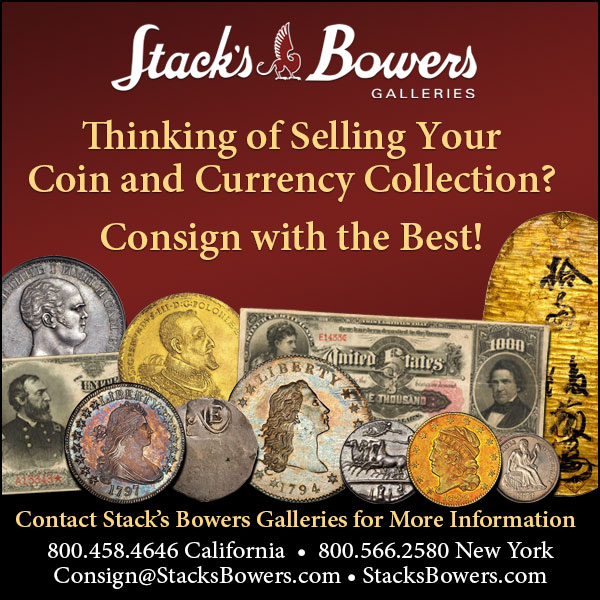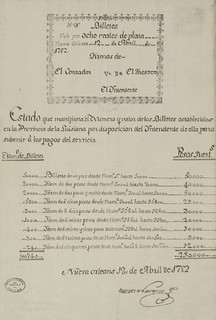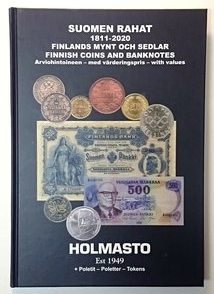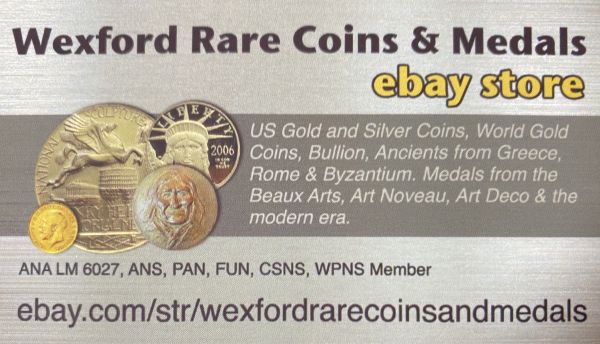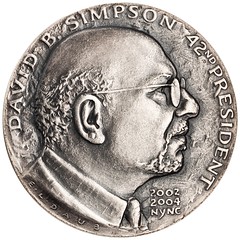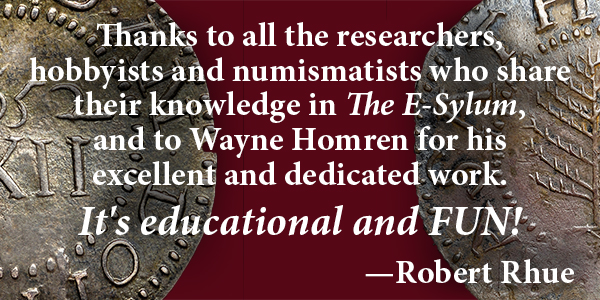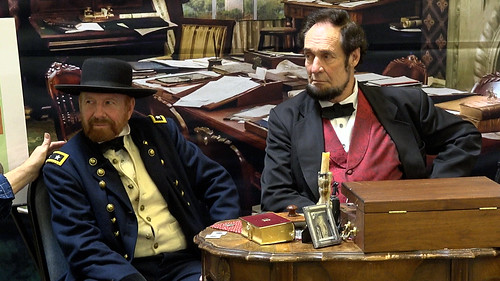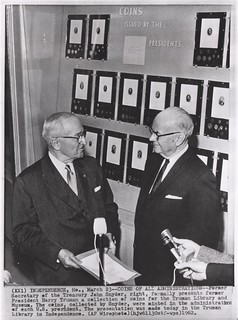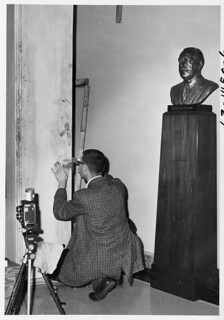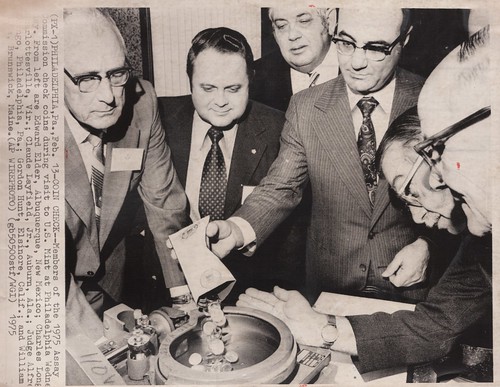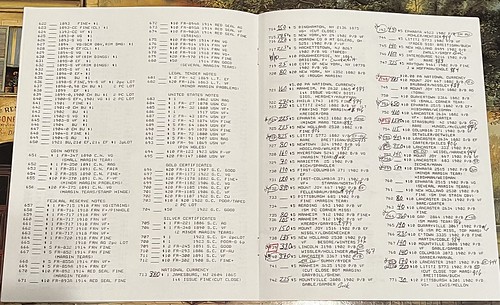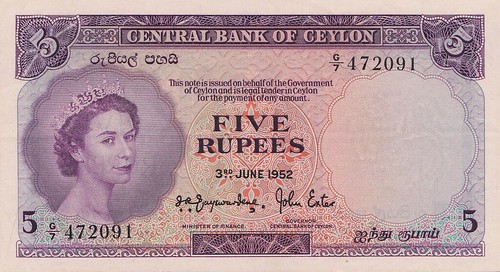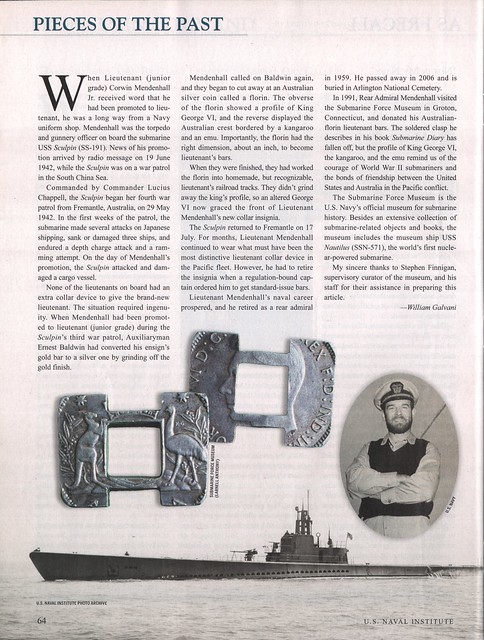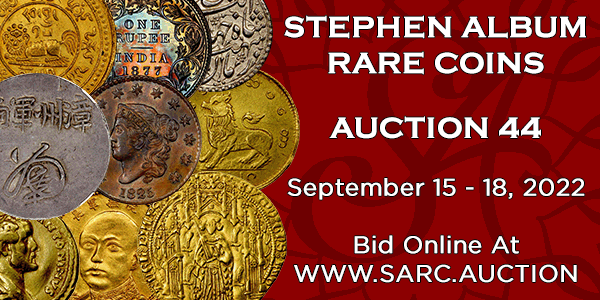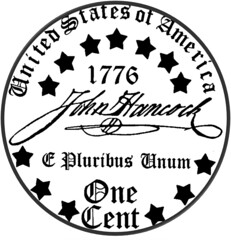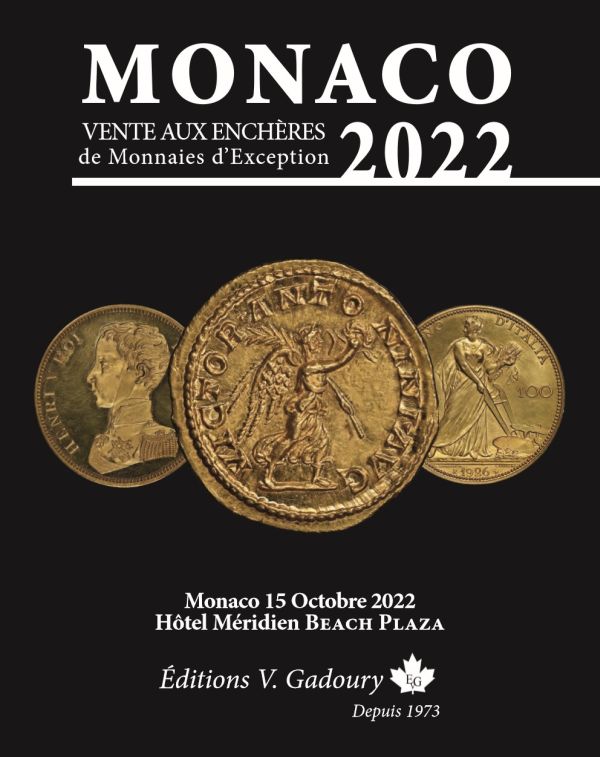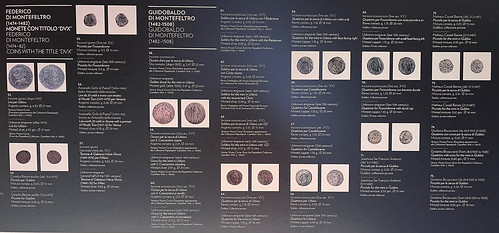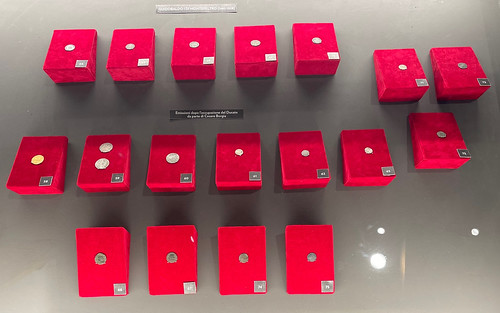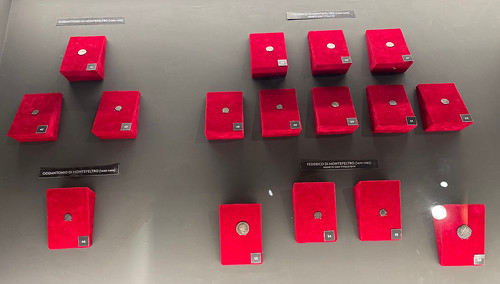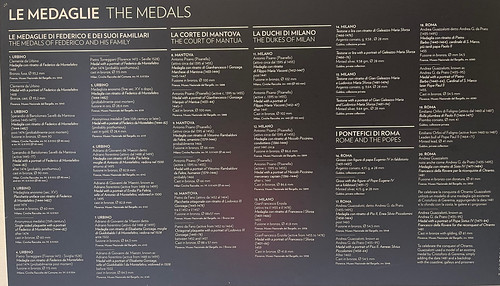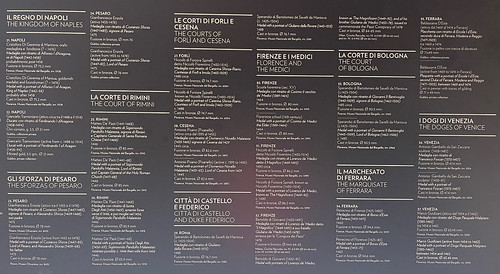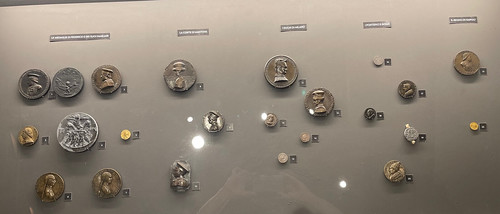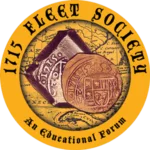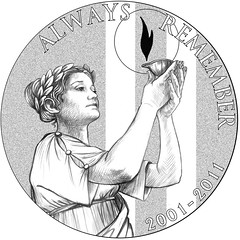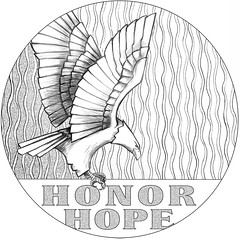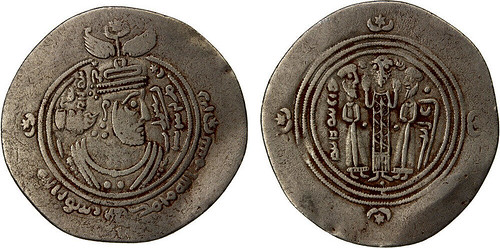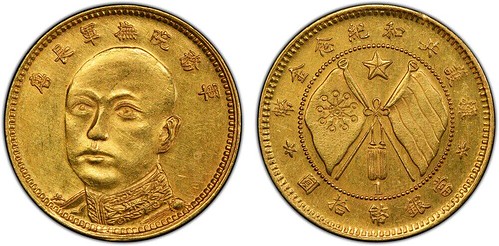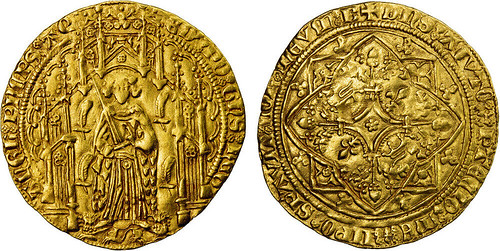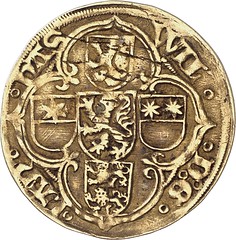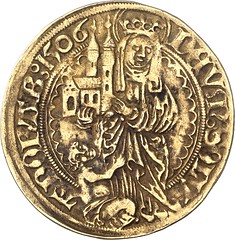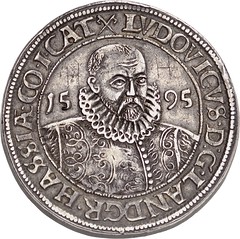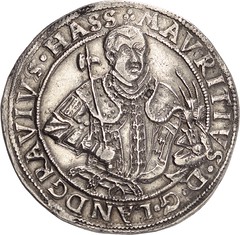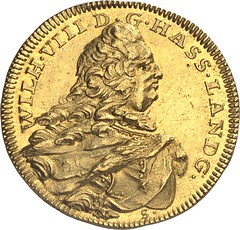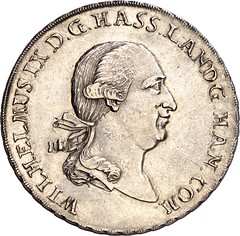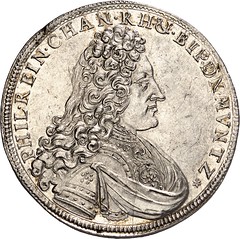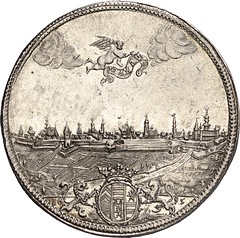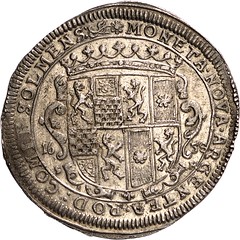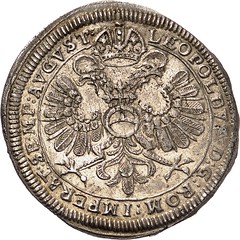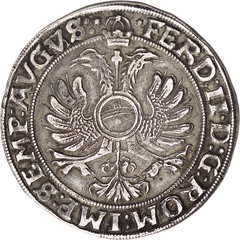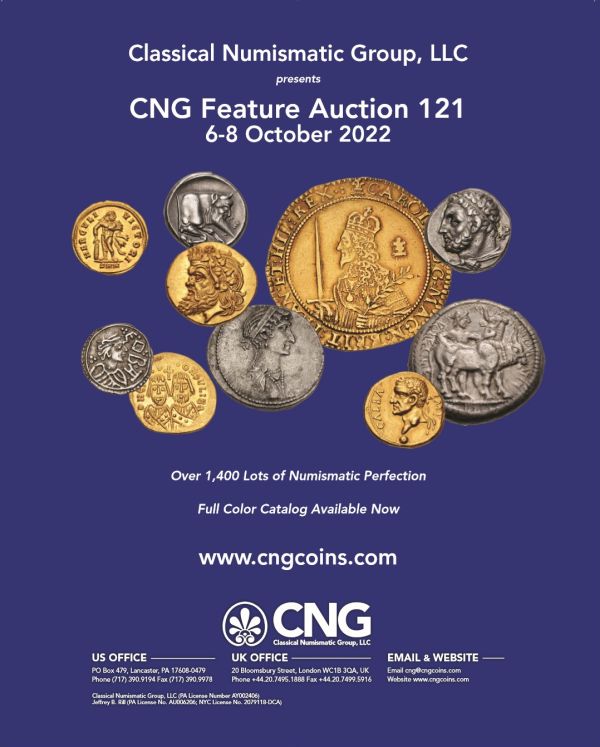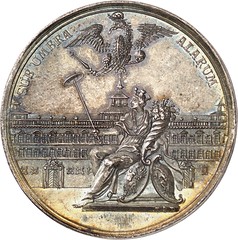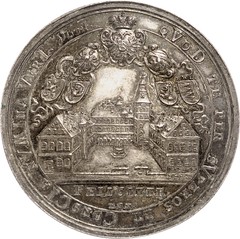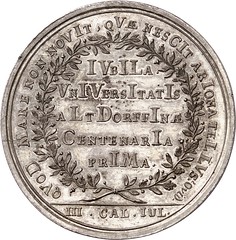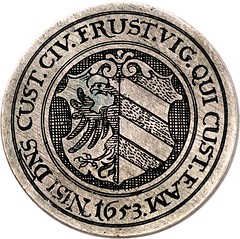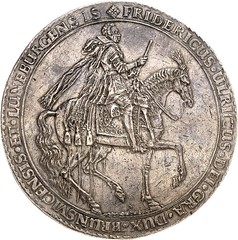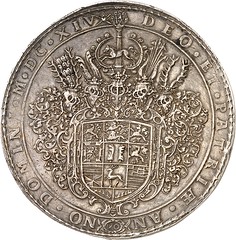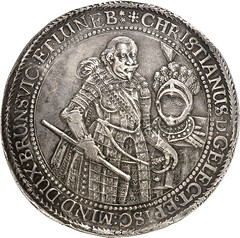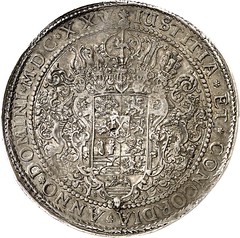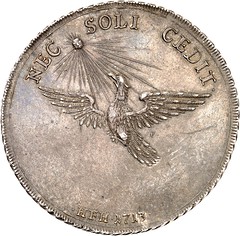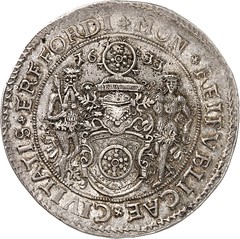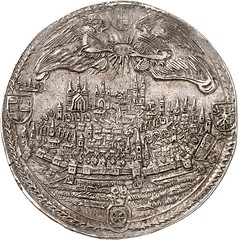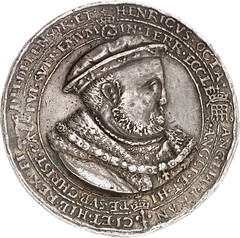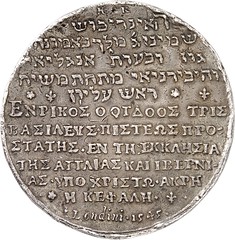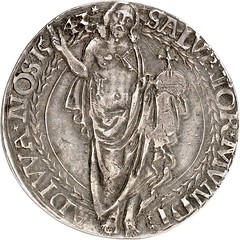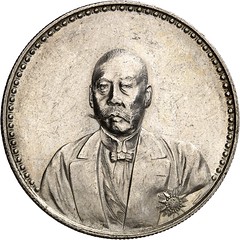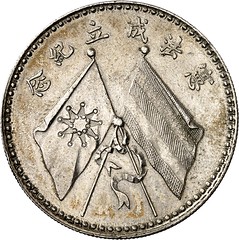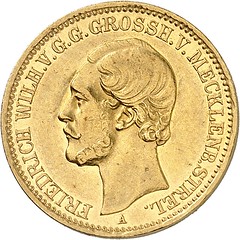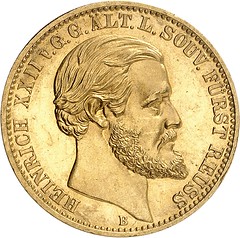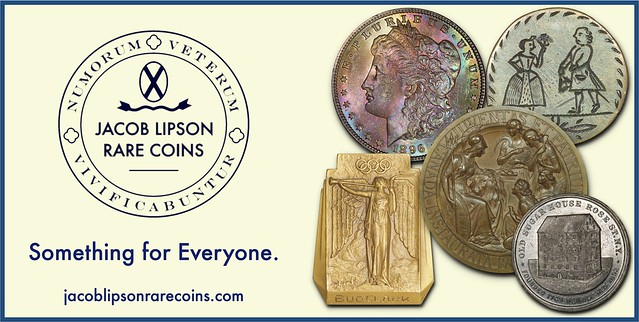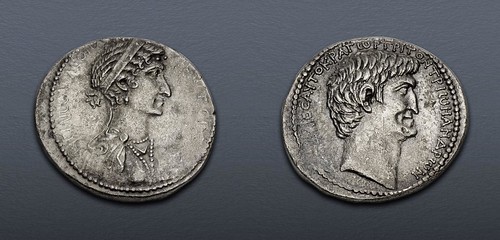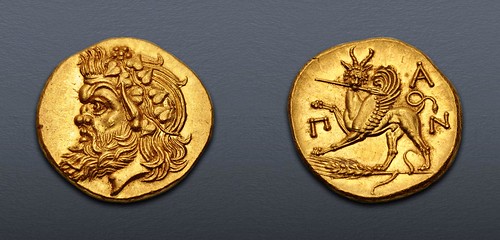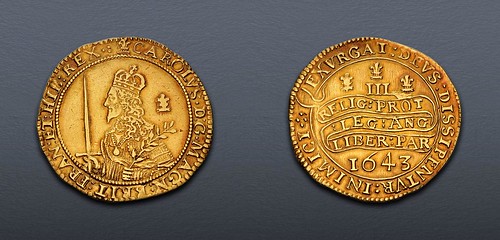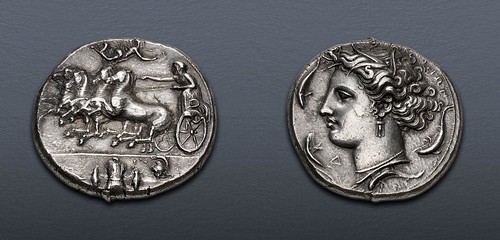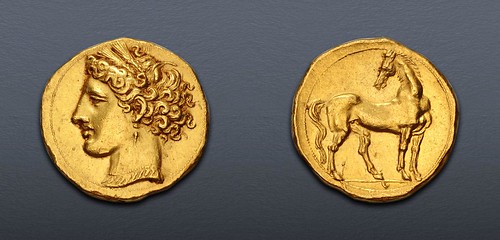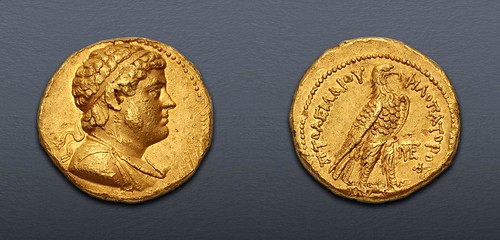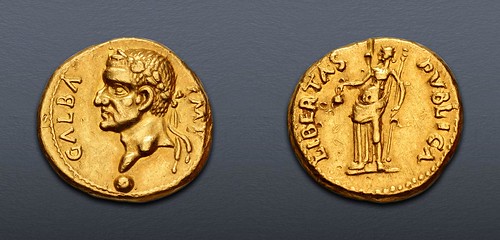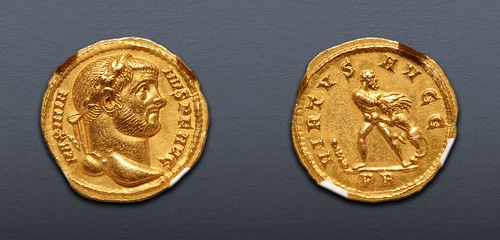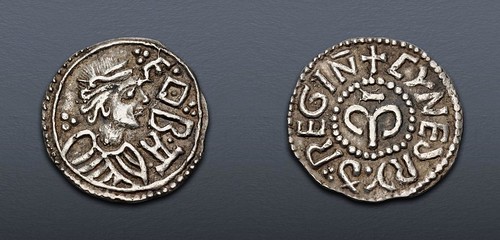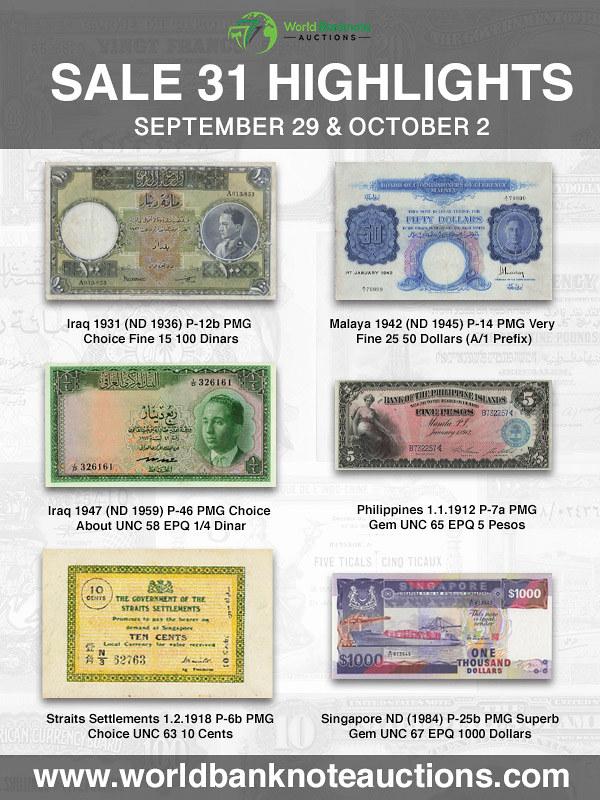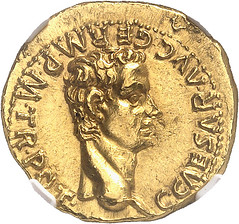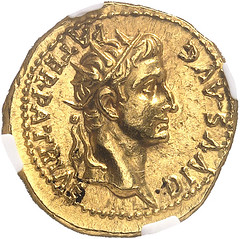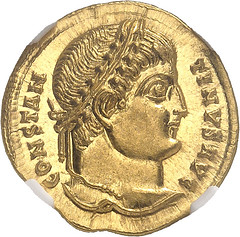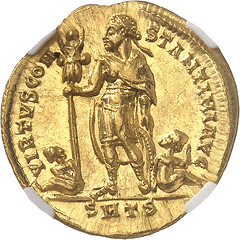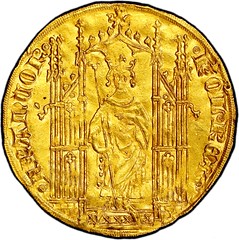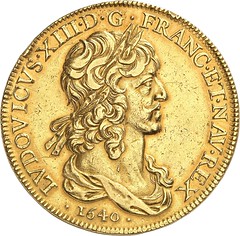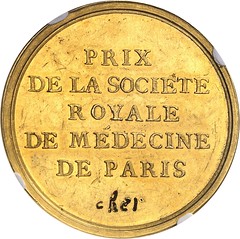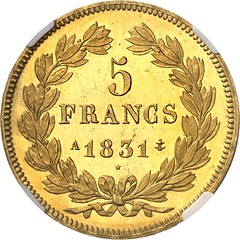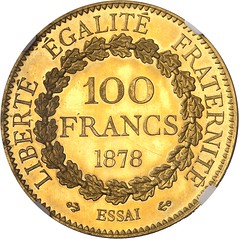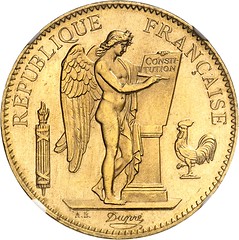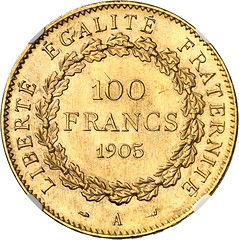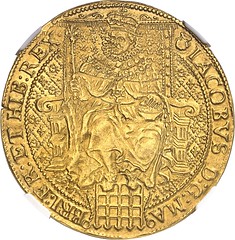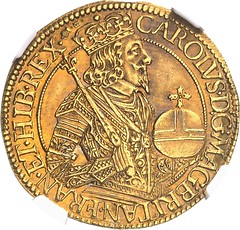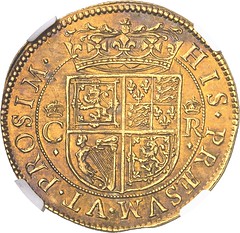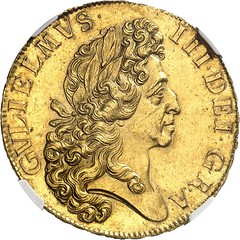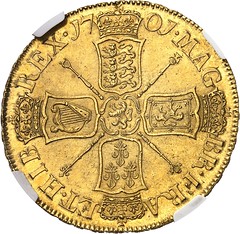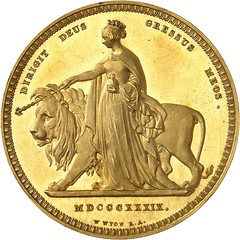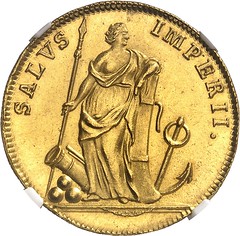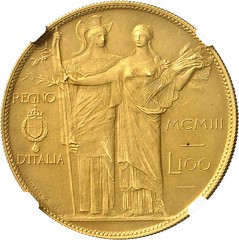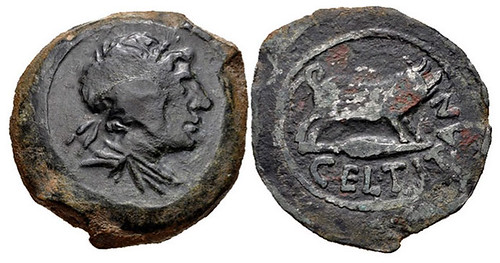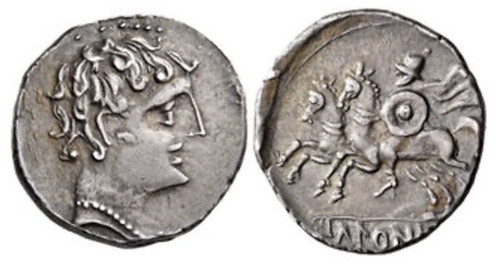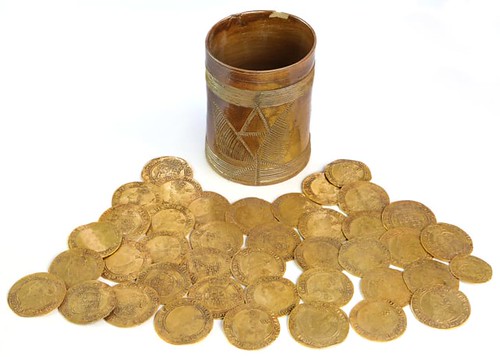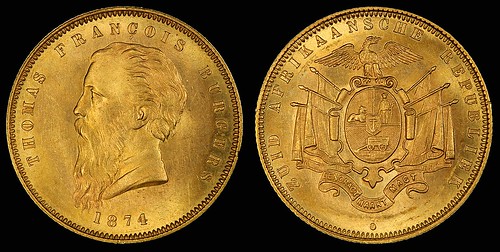
Visit our NBS Sponsors



About UsThe Numismatic Bibliomania Society is a non-profit association devoted to the study and enjoyment of numismatic literature. For more information please see our web site at coinbooks.org SubscriptionsThose wishing to become new E-Sylum subscribers (or wishing to Unsubscribe) can go to the following web page link MembershipThere is a membership application available on the web site Membership Application To join, print the application and return it with your check to the address printed on the application. Print/Digital membership is $40 to addresses in the U.S., and $60 elsewhere. A digital-only membership is available for $25. For those without web access, write to: Charles Heck, Treasurer AsylumFor Asylum mailing address changes and other membership questions, contact Chuck at this email address: treasurer@coinbooks.org SubmissionsTo submit items for publication in The E-Sylum, write to the Editor at this address: whomren@gmail.com BUY THE BOOK BEFORE THE COINSale Calendar |
- WAYNE'S WORDS: THE E-SYLUM SEPTEMBER 11, 2022
- ASYLUM AUTUMN 2022 ISSUE PUBLISHED
- NEW BOOK: PAPER MONEY IN LOUISIANA
- NEW BOOKS ON FINNISH NUMISMATICS
- BOOK REVIEW: THE DIARY OF ISAAC MICKLE
- QUEEN ELIZABETH II (1926-2022)
- DAVID B. SIMPSON (1938-2022)
- SILVER, GOLD, AND CURRENCY CONVERSION IN 1857
- VIDEO: MONIES OF THE CIVIL WAR
- TRUMAN LIBRARY THEFT, 1975 ASSAY COMMISSION
- THE ROBERT M. RAMSAY COLLECTION SALE CATALOG
- NOTES FROM E-SYLUM READERS: SEPTEMBER 11, 2022
- MORE 2026 INDEPENDENCE COMMEMORATIVE IDEAS
- UMBRIA DUCAL PALACE COIN AND MEDAL EXHIBIT
- 2022 NUMISMATIC WRITERS ANA AWARDS
- VOCABULARY TERMS: LUCKY CHARM, LUCKY PENNY
- WILLOW GENE HERREN DENISE (1904-1966)
- 1715 FLEET SOCIETY CONFERENCE
- NUMISMATICS AND SEPTEMBER 11, 2001
- STEPHEN ALBUM RARE COINS AUCTION 44
- KÜNKER AUCTION SALE 374 HIGHLIGHTS
- KÜNKER AUCTION SALE 375 HIGHLIGHTS
- CNG FEATURE AUCTION 121 HIGHLIGHTS
- MDC MONACO OCTOBER 2022 SALE
- COINS OF THE CELTIBERIANS
- DOES BYZANTINE COIN SHOW A SUPERNOVA?
- 18TH CENTURY ENGLISH GOLD COIN HOARD FOUND
- FORT LAFAYETTE CIVIL WAR TOKEN
- THE QUEEN'S CURRENCY
- LOOSE CHANGE: SEPTEMBER 11, 2022
Click here to read the thin version on the web
Click here to subscribe
Click here to access the complete archive
To comment or submit articles, reply to whomren@gmail.com
Content presented in The E-Sylum is not necessarily researched or independently fact-checked, and views expressed do not necessarily represent those of the Numismatic Bibliomania Society.
WAYNE'S WORDS: THE E-SYLUM SEPTEMBER 11, 2022
 New subscribers this week include:
Rick Dupuis of the Ontario Numismatic Society, courtesy Bob Fritsch;
Welcome aboard!
New subscribers this week include:
Rick Dupuis of the Ontario Numismatic Society, courtesy Bob Fritsch;
Welcome aboard!
Thank you for reading The E-Sylum. If you enjoy it, please send me the email addresses of friends you think may enjoy it as well and I'll send them a subscription. Contact me at whomren@gmail.com anytime regarding your subscription, or questions, comments or suggestions about our content.
This week we open with news of the latest Asylum issue, two or three new books (depending on how you count), a book review, updates from the Newman Numismatic Portal, and more.
Other topics this week include early paper money in Louisiana, Finnish coins and tokens, collectors Isaac Mickle, John Kane and David Simpson, money of the Civil War, the Truman Library coin collection theft, ANA numismatic writer awards, the 1715 Fleet Society conference, more auction previews, coin finds, and more.
To learn more about the Daniel E. Groux Broadside Sale, the numismatics of Queen Elizabeth II, exchanging silver and gold in 1857, the 1975 Annual Assay Commission, the first auction catalog image of paper money, Things Book Lovers Do, the Umbria Ducal Palace exhibit, lucky pennies, numismatics and 9/11, Edward the Black Prince, Cleopatra & Antony, and the only Celtic coin that says it is, read on. Have a great week, everyone!
Wayne Homren
Editor, The E-Sylum
ASYLUM AUTUMN 2022 ISSUE PUBLISHED
The Autumn 2022 issue of The Asylum is on the way from our sponsor, the Numismatic Bibliomania Society. Maria Fanning edits our print journal, and she submitted this report and President Tom Harrison's message. Thanks. -Editor
 The Asylum's Autumn 2022 issue will be mailing to NBS members soon. Thanks to everyone who sent in photos from the ANA in Rosemont this year. It great to see fellow bibliomaniacs and we hope to see more of you in Pittsburgh next August.
The Asylum's Autumn 2022 issue will be mailing to NBS members soon. Thanks to everyone who sent in photos from the ANA in Rosemont this year. It great to see fellow bibliomaniacs and we hope to see more of you in Pittsburgh next August.
For the second year in a row the ANA has given The E-Sylum first place in the Electronic category of the Barbara J. Gregory Outstanding Club Publications competition. The Asylum won third place in the Special Publications category, as well. Keep the submissions coming!
We would love to receive more contributions, especially any experiences and opinions on having treasures bound, working with a bindery, and advice on when and how to do so.
In this issue:
- NBS 2022 Symposium and General Meeting Reports by Joel J. Orosz
- The NBS at ANA
- "Etched in Steel but not Paper: The Lack of Writings from the Chief Engravers of the Mint" by Mike Costanzo
- "Frossard's Sale 78: The Trivulzio Library, Part II" by David F. Fanning
- "Enigmatic Numismystique: The Numismatist Purchase of 1908—Labor and Love" by Douglas Ward
- "ASSOCIATIONS: Autographs • Annotations • Inscriptions Charles Ira Bushnell's Flandin's Catalogue of Coins and Medals: Part III, The Daniel E. Groux Broadside Sale, February 15, 1856" by Joel J. Orosz
President's Message
By Tom Harrison
Again this year, numismatic bibliophiles converged on the ANA World's Fair of Money in Rosemont, Illinois, from all four corners of the United States and numerous points in between. From Tuesday through Friday the NBS hosted their club table, strategically placed next to literature dealer Charles Davis's booth. The table gave convention attendees a chance to purchase a commemorative coffee mug to support the NBS, view highlights from Friday's charity auction, and most of all, it provided a gathering point for sharing their bibliomania.
Conventioneers were treated to an outstanding nine-case literature display titled A Select Numismatic Literature Collection,
created by Erwin Brauer. Volumes displayed included rare items authored by Dickeson, Ormsby and Beazel.
NBS Treasurer, Chuck Heck, presented an entertaining and informative talk detailing his research and the production of his enlightening new book, Die States of 1794 United States Large Cents, at Thursday's Symposium. Chuck addressed a number of challenges and detailed solutions to help prospective authors navigate the complexities of publication.
I am pleased to report that both The Asylum and The E-Sylum received recognization at the ANA awards ceremony Thursday afternoon. The E-Sylum received first place in the electronic category of the Barbra J. Gregory Outstanding Club Publication Competition. Congratulations to Wayne, Bruce, John, and all of The E-Sylum contributors and advertisers for this well-deserved award. For over twenty years, The E-Sylum remains one of the real treasures of the numismatic community. The Asylum brought home third place in the speciality category of the Outstanding Club Publication Competition. Congratulations to our talented editor, Maria Fanning, and the first-class authors who, together with Maria, continue to make The Asylum one of the premier numismatic journals.
Highlights of Friday's General Meeting included the presentation of the George Fredrick Kolbe Lifetime Achievement Award, the annual charity auction, The Asylum author awards and a video tour of the amazing Joel Orosz numismatic library. The Kolbe award was presented to long-time literature dealer, author and NBS supporter, Charles Davis, a former NBS Board member and a past editor of The Asylum. Again this year, several generous donors stepped forward to provide fifty quality lots for the charity auction for which enthusiastic bidders competed to raise funds to support the NBS. On behalf of the NBS membership, I extend a heartfelt thank you to the open-handed members who raised over $10,000 for the NBS! The Jack Collin's Award was presented to Charles Sullivan and the Joel J. Orosz Award to Jim Neiswinter. In July, Len Augsburger and Lianna Spurrier produced a video recording of NBS Historian, Joel Orosz's, extensive library. As a result of their efforts and Joel's hospitality, we had an opportunity to enjoy a video tour and view a number of special volumes including an extensive collection of NBS archival material dating back to the society's inception. New this year, members were invited to remain for an informal social time following the formal part of the meeting to share a special item from their libraries and connect with old friends and new acquaintances.
The bibliophiles' week was capped off with a well-attended Money Talks presentation by NBS Vice President, Len Augsburger, titled Building a Numismatic Library for Pleasure and Profit.
Len's discussion focused on different collecting strategies and the wide range of opportunities collectors have to assemble a significant library regardless of one's budget.
It was a great week of biblio fun and education thanks to the efforts of many dedicated members who generously gave their time and resources. Many thanks to everyone for your continued commitment to the NBS! Be sure to read Joel Orosz's detailed reports about the Symposium and General Meeting in this issue.
May your library provide investigation, discovery and most of all, enjoyment.
Remember, while The E-Sylum is free to all, only paid members of the Numismatic Bibliomania Society receive our print journal, The Asylum. Print/Digital membership is $40 to addresses in the U.S., and $60 elsewhere. A digital-only membership is available for just $25. -Editor
To join NBS or renew your membership, see:
https://www.coinbooks.org/about/membership.html
NEW BOOK: PAPER MONEY IN LOUISIANA
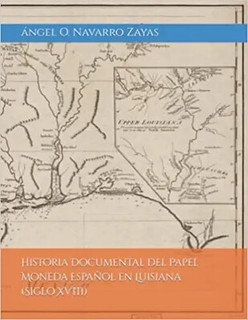 Documentary History of Spanish Paper Money in Louisiana (18th Century)
Documentary History of Spanish Paper Money in Louisiana (18th Century)
Author: Ángel O. Navarro Zayas
Publisher : Independently published (August 29, 2022)
Language : Spanish
Paperback : 173 pages
ISBN-13 : 979-8848868197
Item Weight : 1.26 pounds
Dimensions : 8.5 x 0.41 x 11 inches
Len Augsburger writes:
"Ángel O. Navarro Zayas has mined archival sources in order to provide a complete picture of the efforts related to the introduction of paper money in Spanish Louisiana. This thoroughly researched volume represents a valuable addition to existing studies on early American paper money."
While the Newman Numismatic Portal is a marvelous resource for numismatic researchers, one mustn't stop there when the goal is to uncover previously unknown information. Ángel's discovery and review of primary documents has shed new light on this important area of early paper money in what is now the United States of America.
Most of the book is in Spanish but it has lengthy translations of some of the primary documents that were transcribed from the General Archive of the Indies. -Editor
Here is a note from the President of the Numismatic Society of Puerto Rico, Dra. Dámaris Mercado-Martínez -Editor
We have the opportunity, due to the honorable invitation of Dr. Ángel O. Navarro Zayas, a numismatic friend, researcher and academic from Ponce, recognized by the Numismatic Society of Puerto Rico and by other numismatic entities, to capture some notes on his new book. In In this presentation we want to highlight, first of all, the notable effort of the author to work on some transcriptions of primary sources from the General Archive of the Indies, regarding the paper money issued in Spanish Louisiana at the end of the 18th century.These documents are a great numismatic discovery of Dr. Navarro that pay Spanish monetary history in its extensive territory in North America, collected by him under the title : "Documentary History of Spanish Paper Money in Louisiana (18th Century)".
In this work we will find informative and explanatory notes documented by the transcriptions and by the illustrated reproductions at first hand, of the Spanish royal vouchers and paper money issued as a consequence of a great inflation in the territory of Louisiana, in the relationship between the future of some historical processes of this territory and the appearance of some monetary instruments little tested at that time. The work consists of a few words by the author in which he briefly describes the type of study carried out by him and we quote him: ¨The documents presented here are faithful and exact transcriptions of the documents found in the Archivo General de Indias referring to said subject…. the translation of two somewhat inaccurate files of the documents into English so that Anglo-Saxon speakers can make use of the documents ¨ Next we find a succinct and important introduction, historical and numismatic, made by the Spanish numismatist friend, Dr. Pedro Damian Cano.
The presentation of the documentary transcripts and the reproductions, are shown from the year 1782, with descriptions of " the bills of eight reals of silver established in the Province of Louisiana to subsidize the payments for services".. Later, we will find the different real vouchers of the denominations of 25, 30, 40, 50, 60, 70, 80, 90 and 100 pesos, from the years 1793 and 1795, ´to run and circulate in it (Louisiana) as the usual and effective currency . Likewise, the transcripts mention the printed bills of different values, ¨ due to the lack of Located ¨ since 1789.
We found the tests of the Vales Reales of two and eight curious. But very interesting are the transcripts of the files of 1795 and 1796 on the petition-plea to the king for the creation of one million pesos in royal vouchers of various kinds for the relief of the Province of Louisiana, for the fatal accident of a raging fire, which suffered the Capital (New Orleans), on December 8, 1794. Louisiana was the bulwark against the most fearsome nation in the New World, but it was in danger for other different reasons: there was depopulation in the extensive territory, they did not have mines of the precious metals gold and silver, it had little money, its annual position was short, its commercial traffic was almost all with strangers, and it became the most unpunished place for any monetary operation...

The research was sponsored in part by a 2020 Newman Grant from the Eric P. Newman Numismatic Education Society. -Editor
To read the earlier E-Sylum article, see:
EPNNES AWARDS 2020 NEWMAN GRANTS
(https://www.coinbooks.org/v23/esylum_v23n21a05.html)
For more information, or to order, see:
Documentary History of Spanish Paper Money in Louisiana (18th Century) (Spanish Edition) Paperback – August 29, 2022
(https://www.amazon.com/Historia-Documental-Espa%C3%B1ol-Luisiana-Spanish/dp/B0BC6ZV12P/ref=sr_1_2)
NEW BOOKS ON FINNISH NUMISMATICS
Yosef Sa'ar of Elat on the Red Sea submitted these notes on a new double-book on Finnish numismatics. Thanks! -Editor
This is to report a rather unique book on Finnish numismatics. Actually it is two books in one, bound together, inverted back to back.
"Suomen Rahat 1811-2020" by Holmasto Team, 2021, is a 111 page catalog of Finnish coins and paper money. When you flip the book, you have "Suomalaiset poletit - Finska poletter" by Antti Vuori, 2021, a 70 page catalog of Finnish tokens.The publisher is Holmasto of Helsinki.
Both works are extensively illustrated in color. Recommended if you collect Finland.
I purchased my copy from Tampereen Raha-apaja Ky in Tampere.
For more information, or to order, see:
https://raha-apaja.fi/
BOOK REVIEW: THE DIARY OF ISAAC MICKLE
Mike Costanzo submitted these notes on the diary of early coin collector Isaac Mickle. Thank you! -Editor
 A Gentleman of Much Promise; The Diary of Isaac Mickle 1837-1845, (University of Pennsylvania Press, 1977) may be of interest due to the fact that Mickle was also a numismatist. Aside from keeping a diary, he occasionally attended coin auctions as well as visited fellow collectors.
One such visit occurred on Sunday, September 27,1840, when Mickle was seventeen years old:
A Gentleman of Much Promise; The Diary of Isaac Mickle 1837-1845, (University of Pennsylvania Press, 1977) may be of interest due to the fact that Mickle was also a numismatist. Aside from keeping a diary, he occasionally attended coin auctions as well as visited fellow collectors.
One such visit occurred on Sunday, September 27,1840, when Mickle was seventeen years old:
"I went over the river this morning to look at a collection of curious coins owned by a certain John Kane who is a complete original in the great family of fools. He carries his love for his hobby to such a length, that while he has medals and coins to the value of an hundred, nay, a thousand dollars, he hardly has a crust of bread for his children or a whole shirt for himself. Judging from his house and the appearance of every thing in it, you would suppose that poverty could make him no poorer; but judging from the cabinet of coins which he exhibits to you, you would take him to be some princely antiquarian and connoisseur, to whom the riches of Potosi* would be no object. Such are the eccentricities of man!"
(*Potosi was a Bolivian city with rich silver mines)
Mickle's description of Kane's residence and personal living habits in relation to his impressive coin collection are revealing. I believe every numismatist, myself included, has at some time or another wondered if they were "crossing the line" when it came to adding to their collection, compared to paying the rent or other basic amenities, and feared that they might see "John Kane" in their own mirror. All collectors experience a healthy sense of guilt when it comes to their hobby, whether it be monetary or even time spent on it. But it's comforting to know collectors have wrestled with this through the ages, and probably always will.
Personally, I keep my collecting in check by reminding myself that great collections, such as Eric P. Newman's, took a lifetime to complete, while J.P. Morgan's took tons of cash.
And don't look to Freud for answers, even he collected stuff!
A copy of the book, donated by Joel Orosz, was sold as lot 23 in the recent 2022 Charity Auction at the General Meeting of the Numismatic Bibliomania Society. Here's the lot description from David Fanning's catalog. -Editor
Diary of an Early Collector
23 Mickle, Isaac. A GENTLEMAN OF MUCH PROMISE: THE DIARY OF ISAAC MICKLE
1837–1845. Edited by Philip English Mackey. Philadelphia: University of Pennsylvania Press, 1977.
Two volumes, complete. 8vo, original matching russet cloth, gilt, and yellow boards; endpaper
maps. xxviii, (2), 248, (2), (6), 251–531, (1) pages; occasional text illustrations. Housed as issued in
accompanying slipcase. Near fine. $80
Mickle was an early American numismatist who occasionally discussed his interest, and the collections of others, in
this diary. As early as 1840, he associated with collector Joseph B. Cooper, and he attended the September 28, 1840 auction sale at Birch's of the Godfrey Krumback collection, an extremely early U.S. numismatic auction sale. Little known.
Ex Black River Books, 2020.
Donated by Joel Orosz
To read the complete sale catalog, see:
2022 CHARITY AUCTION
(https://www.coinbooks.org/resources/NBSAuction2022.pdf)
QUEEN ELIZABETH II (1926-2022)
David Pickup submitted these thoughts on the passing of Queen Elizabeth II. -Editor
Elizabeth the Great
 The lives of kings and queens is an essential part of numismatics. The passing of
Her Majesty on Thursday is the end of an era. Most of us have never known a
different monarch. Numismatically her reign started with the new issues bearing the
Gillick portrait. That image was controversial at the time but it is now regarded as
youthful and full of grace. The royal titles on the 1953 coins have BRITT OMN but
this was only used for that year
The lives of kings and queens is an essential part of numismatics. The passing of
Her Majesty on Thursday is the end of an era. Most of us have never known a
different monarch. Numismatically her reign started with the new issues bearing the
Gillick portrait. That image was controversial at the time but it is now regarded as
youthful and full of grace. The royal titles on the 1953 coins have BRITT OMN but
this was only used for that year
Her portraits changed over the years, beginning with a portrait designed by Arnold
Machin for the new decimal coins from 1968 although D Day was not until 1971.
New pence
quickly became just pence
. The third portrait of the Queen was
designed in 1985 by Raphael Maclouf. The fourth portrait of the Queen was
designed by Ian Rank-Broadley. The last portrait was designed by Jody Clark in
2015 and shows the Queen with the Royal Diamond Diadem Crown, which she wore
for her Coronation in 1953. Many coins were issued to mark Royal and national
events over her seventy year reign. She appears on the coins of many
commonwealth countries.
Her Majesty offered continuity in a world that changes too quickly. Rulers come and
go but not many could justly claim the title The Great
. She is entitled to that
because of her many years of service and devotion to duty. She was not only the
Queen of the United Kingdom but also of fifteen countries spanning nearly every continent. She was
a vital link to many other nations and people across the world which we value so
much. By tradition the portrait of the new king on his coins will face the opposite
direction to the predecessor. It will be interesting to see what royal titles will be used
on his coins.
We look back on her long reign with pride and gratitude and look forward to the reign of Charles III
God save the King
Thank you. Our thoughts are with our friends in the United Kingdom and commonwealth countries. Elizabeth II was truly a great Queen.
Here's one of the countless articles and news reports published following her death, and it happened to incorporate numismatics. Marketplace Morning Report ran a special episode about all the money in circulation bearing her image and the economic impact of a country in mourning. -Editor
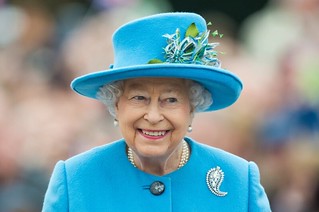 From the BBC World Service: The United Kingdom and the world is remembering the life of Queen Elizabeth II, who has died. Her reign of 70 years was the longest in British history and she witnessed enormous political changes, including the development of the Commonwealth. In the U.K., a period of royal mourning will be observed until seven days after the Queen's funeral and many sports events and businesses are also changing their plans for the coming days.
From the BBC World Service: The United Kingdom and the world is remembering the life of Queen Elizabeth II, who has died. Her reign of 70 years was the longest in British history and she witnessed enormous political changes, including the development of the Commonwealth. In the U.K., a period of royal mourning will be observed until seven days after the Queen's funeral and many sports events and businesses are also changing their plans for the coming days.
To listen to the broadcast, see:
https://www.marketplace.org/shows/marketplace-morning-report/the-world-joins-the-u-k-in-mourning-the-death-of-queen-elizabeth-ii/
(https://www.marketplace.org/shows/marketplace-morning-report/the-world-joins-the-u-k-in-mourning-the-death-of-queen-elizabeth-ii/)
Here's the reaction from the Royal Mint. -Editor
Anne Jessopp, Chief Executive Officer at The Royal Mint, said:
"On behalf of everyone at The Royal Mint, I would like to extend our heartfelt sympathy to The Royal Family at this extraordinarily sad time.
Queen Elizabeth II ruled with heart and devotion, and will be dearly missed by all of us at The Royal Mint and by millions of people around the world.
The Royal Mint worked with Her Late Majesty throughout her reign – detailing her journey from new Queen to respected head of state across five coin portraits, and ensuring each new UK coin received her personal seal of approval. The remarkable legacy of Britain's longest serving monarch will live on for many years to come."
The Royal Mint noted that "all United Kingdom circulating coins bearing portraits of Queen Elizabeth II remain legal tender and in circulation." Coins bearing her portrait continue to be struck, and the Royal Mint Experience remained open for visitors, with a book of condolence available for visitors to sign. See the mint site for articles including "Five portraits of Her Majesty Queen Elizabeth II" and "The first coins struck for Elizabeth II". -Editor
To visit the Royal Mint website, see:
https://www.royalmint.com/
David adds:
"There was a queue on the Royal Mint website of over 10,000.00 on Thursday night."
The Wall Street Journal wrote about the upcoming changes to coins and currency. -Editor
After 70 years on the throne, Queen Elizabeth II's name, title, face and likeness are deeply ingrained not just on the hearts of many Britons, but more tangibly on British coins, flags, post boxes, chocolate wrappers, gin labels and attorney business cards.
That all has to change now that Charles is in charge.
With the queen's death, the U.K. has begun an imperial-sized rebrand that will slowly replace her image and title with that of the new king, Charles III. Among the items that will have to eventually be rebranded: 29 billion coins and 4.7 billion bank notes in circulation.
The Royal Mint, which produces the coins, and the Bank of England, which oversees the notes, will phase in new bills and coins adorned with King Charles, but that could take months and even years: The government is in the final throes of phasing out paper bills in favor of longer-lasting polymer notes.
To reassure an anxious public, the Bank of England came out with a statement following the queen's death that bills with her face on them would continue to be legal tender.
One change on the new currency: The new monarch will face left, while the queen faces right. It has long been tradition in the U.K. for each successive monarch to face a different direction than their predecessor, signaling a new era. A spokeswoman for The Royal Mint declined to provide details of the shift in coins.
Numismatic reverberations will extend beyond the British Isles, to many members of the Commonwealth. Canada has had the queen on its $20 bill since 1954—she made a cameo as a princess in the 1930s—and her face adorns the coins of Australia and New Zealand. She is particularly popular on currency in the Caribbean: Her face appears on the currencies of eight nations and territories there.
For philatelists, the article also discusses changes to stamps and mailboxes. -Editor
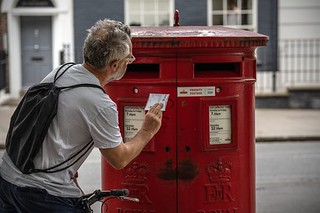 More gradual still is the Royal Mail, whose distinct, fire engine-red mailboxes are sprinkled on sidewalks across Britain. While it is expected to eventually roll out new stamps bearing the king's face, its mailboxes—which carry the queen's cipher, a kind of monogram with her first initial—historically have remained for as long as they're useful, in some cases more than a century.
More gradual still is the Royal Mail, whose distinct, fire engine-red mailboxes are sprinkled on sidewalks across Britain. While it is expected to eventually roll out new stamps bearing the king's face, its mailboxes—which carry the queen's cipher, a kind of monogram with her first initial—historically have remained for as long as they're useful, in some cases more than a century.
Despite her 70-year reign, only about 60% of the country's post boxes were installed under Queen Elizabeth, according to the Royal Mail, while 15% remain from the time of George V, and even some remain bearing the cipher of Queen Victoria.
To read the complete article (subscription required), see:
Queen's Death Brings a King-Size Rebranding of Coins, Cookies and Committees
(https://www.wsj.com/articles/queen-elizabeth-king-charles-rebranding-11662762733)
Len Augsbuerger passed along a New York Times article on the topic:
Why King Charles's profile may face left on British coins, and why it matters.
(https://www.nytimes.com/live/2022/09/09/world/queen-elizabeth-king-charles#king-charles-bank-notes-coins-currency)
In 1968 there was a reunion in London of all the Victoria Cross and George Cross winners. A 15-year-old girl from India accompanied her father on the trip. -Editor
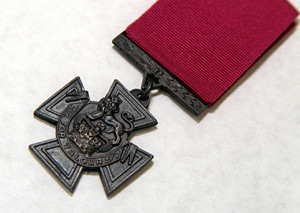 We heard whispers that the Queen would be with us soon. There was a hushed silence and suddenly from the balcony we heard the band strike up
We heard whispers that the Queen would be with us soon. There was a hushed silence and suddenly from the balcony we heard the band strike up God Save the Queen,
and there she was with Prince Philip and some officials. We stood in hushed silence till the anthem ended and before I could get my wits together, she was introduced to our little gathering of about four people. The officer whispered something to her and she came up to me and my mother. We shook hands. She looked very pretty and petite and had a flawless skin and wore a small tiara on her hair. She smiled at me and said, You are a lucky young lady to have such a brave father.
I thanked her and she asked me if this was my first trip to England. I said it was and at this point she started telling me about all the sights I must see. She told me about Madame Tussauds, which was definitely on my list as at one time it had a bust of my father. She also told me about the of Tower of London and a trip down the Thames and what to look out for. While she was describing these places, I could not help but wondering how very caring she was to even think of taking so much time to explain all this to a star-struck teenager, who she instantly made comfortable. I was touched by her thoughtfulness.
To read the complete article, see:
My one lasting impression of the Queen
(https://timesofindia.indiatimes.com/blogs/no-free-lunch/my-one-lasting-impression-of-the-queen/)
Her Majesty had a great sense of humor all her life. -Editor
James Bond knew it. Paddington Bear knew it. Even her bodyguard chatting to the clueless American hiker knew it.
Queen Elizabeth II had a wicked sense of humor.
A favorite story about the queen that is doing the rounds on social media involves the time when she was asked by an American tourist who was hiking near her Balmoral estate in the Scottish highlands: Had she ever met the queen?
I haven't,
said the queen. Then she pointed at her protection officer Richard Griffin and said he meets her regularly.
To read the complete article, see:
The queen was wickedly funny, as James Bond and Paddington Bear found out
(https://www.washingtonpost.com/world/2022/09/09/queen-england-humor-death/)
DAVID B. SIMPSON (1938-2022)
Scott Miller submitted this obituary of ANS and New York Numismatic Club officer David Simpson. Thank you. The photo is of David visiting the Cornell campus in 2020. -Editor
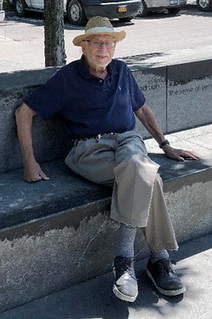 David Baruch Simpson (1938-2022) passed away on September 5, 2022. A numismatist for most of his life, he began collecting world crowns, and later turned to Greek Imperial (Roman Provincial) coins depicting mythological subjects. Many of these were shown in an exhibition at Cornell Art Museum in 1994, and published in the accompanying catalogue
David Baruch Simpson (1938-2022) passed away on September 5, 2022. A numismatist for most of his life, he began collecting world crowns, and later turned to Greek Imperial (Roman Provincial) coins depicting mythological subjects. Many of these were shown in an exhibition at Cornell Art Museum in 1994, and published in the accompanying catalogue Emblems of Authority: Greek and Roman Coins from Two Alumni Collections
. In recent years, David turned his collecting interest to medallic art, with an emphasis on World War I, German Expressionist medals, and medals depicting skulls and skeletons. Another interest was in modern art medals; he frequently lent material for exhibition at Medialia Gallery in New York City.
David Simpson joined the New York Numismatic Club in 1979. Following the club's Cursus Honorum, he served as president from 2002-4, and for many years was on the Board of Directors. David was also active as a Fellow of the American Numismatic Society, and was a member of Council for several years.
David received his BA from Cornell University, and graduated from Columbia Law School in 1963. He completed his military service as a JAG reserve officer. Afterwards, he practiced commercial and residential real estate law in New York and New Jersey for more than fifty years. He is survived by his wife, Nancy, three children, three grandchildren, a brother, and his many friends.
Here's an excerpt from his New York Times obit. -Editor
SIMPSON--David Baruch, was born on October 12, 1938 to Selma (Randell) and Leonard Simpson in New York City. He attended Hunter Elementary School and Music and Art High School. He graduated Phi Beta Kappa from Cornell University in 1960, where he majored in English. He was an active member of the Cornell Daily Sun and the Sphinx Head Society. David went on to graduate from Columbia Law School in 1963, where he was a Harlan Fiske Stone Scholar, and he completed his service commitment as a JAG reserve officer. He married Nancy Mae Stein in June 1964. They lived in New York City before moving to Tenafly, New Jersey where they would raise three children, Laura, Catherine, and Gideon, and where he would continue to live for the rest of his life.
David practiced commercial and residential real estate law for over 50 years in both New York and New Jersey. David was a true intellectual, and had a rare love for inquiry. He read and absorbed astonishing amounts and published multiple law review articles in national journals. He was also deeply interested in people and was a tremendous conversationalist. David was a passionate numismatist for much of his life, collecting coins and medallic art. He was a Fellow of the American Numismatic Society, serving on its Council for several years, and was actively involved with the New York Numismatic Club, serving as President from 2002-2004, and later on its Board of Directors.
He could tell you what restaurants, bookstores, and other establishments had once been on just about every block of Manhattan. Most importantly, he was interested in and supported whatever his children and grandchildren were doing, whether it was riding horses, studying math, or fencing. He adored more than anything his three grandchildren, Sam, Michael, and Rachel Bueker, all of whom found him funny, brilliant and always a bit outrageous.
To read the complete article, see:
DAVID SIMPSON
1938 - 2022
(https://www.legacy.com/us/obituaries/nytimes/name/david-simpson-obituary?id=36439128)
SILVER, GOLD, AND CURRENCY CONVERSION IN 1857
The latest addition to the Newman Numismatic Portal is a printed circular from 1857 listing rates for exchanging silver and gold in Philadelphia. Project Coordinator Len Augsburger provided the following report. Thanks. -Editor
Self-Correction of Silver, Gold, and Currency
A single-leaf circular recently loaned to us by Bill Shamhart reveals the complexity of mid-19th century monetary transactions in America. Issued by the Philadelphia house Cronise & Co in 1857, this brochure is addressed 40 (old style 28) South Third Street,
making reference to the Philadelphia Ordinance of 1856, which standardized street numbers in the City of Brotherly Love.
Various exchange rates are expressed for silver coin (prior to the weight reduction in 1853), gold coin, and paper money, with the one southern city (Richmond, VA) discounted the most, at 7 and 8 percent. Pre-1853 halves were worth more than pre-1853 quarters ($1.04 per dollar face value, vs. $1.02½), suggesting that quarters wore harder in circulation, or simply that it was more convenient to handle half dollars in bulk. The same idea is seen with California territorial gold pieces, for which the $50 and $20s were discounted at 0.5% to 1.0%, while $10s were exchanged into silver at a 2% discount. In any case, the clear message is that silver, gold, and paper money were not convertible at par, and that large conversions resulted in non-trivial brokerage fees.
Image: Extract from Banking House of Cronise & Co.,
displaying exchange rates for silver coin.
Link to Banking House of Cronise & Co.
on Newman Portal:
https://archive.org/details/BankingHouseOfCronise
VIDEO: MONIES OF THE CIVIL WAR
These are selections from the David Lisot Video Library that feature news and personalities from the world of coin collecting. David has been attending coin conventions since 1972 and began videotaping in 1985. The Newman Numismatic Portal now lists all David's videos on their website at:
https://nnp.wustl.edu/library/multimediadetail/522852
Here's one on my favorite numismatic subject, monies of the U.S. Civil War. -Editor
Monies of the Civil War: What Was in President Lincoln's & General Sherman's Pockets
Moderators: Rick Lank & Rebecca Rush, Talisman & Coin Productions,
with Dennis Boggs (Abraham Lincoln) & Kris Gulvansen (General Sherman),
David Lisot, Video Producer, CoinTelevision.com.
May 20, 2022.
The Civil War caused turmoil with the finances of both the Union and the Confederacy. Learn what constituted money at that time and what would have been in people's pockets.
David adds:
"Hearing history told through the people that lived at the time is particularly interesting. The Pennsylvania Association of Numismatists (PAN) is dedicated to promoting coin collecting by sponsoring educational lectures. This Civil War Showcase is told by Abe Lincoln and General William T. Sherman at the PAN Convention."
An excerpt of the video is available for viewing on the Coin Television YouTube Channel at:
https://youtu.be/NmwVsqMAk2E
TRUMAN LIBRARY THEFT, 1975 ASSAY COMMISSION
Dave Lange submitted some interesting new numismatic photos. Thanks! -Editor
I acquired a couple more numismatic photos from deaccessioned archives.
The first shows John Wesley Snyder, Treasury Secretary (1946-53) under President Harry S Truman, presenting his former boss with a collection of coins for the Truman Library in Independence, Missouri. Snyder had assembled an example of each coin denomination struck during every presidential administration to date (March 23, 1962). Just months later, in November, the coins were stolen. I believe they were later replaced by the numismatic community, as I recall having seen such an exhibit at the ANA Museum about 40 years ago, evidently on loan from the Truman Library. A public domain image by J. W. Porter of the Kansas City Star, now held by the Truman Library, is also attached. It shows laboratory supervisor Jason T. White taking evidence from the crime scene.
The second photo I acquired includes members of the 1975 Annual Assay Commission. Several appointees were prominent numismatists, but none seem to be in this photo. The Chairman that year was the Honorable Alfred C. Luango (holding the bag).
THE ROBERT M. RAMSAY COLLECTION SALE CATALOG
Kerry Wetterstrom submitted this note on Bob Ramsay and the auction catalogs of Bob Polito. Thanks! -Editor
 I read the latest issue of The E-Sylum, which is always a highlight of my Monday mornings! My attention was immediately grabbed by Pete Smith's note on Robert M. Ramsay. I knew Bob Ramsay, as he was a fellow member of the Red Rose Coin Club here in Lancaster and a regular attendee at club meetings. I remember him as knowledgeable, but also cantankerous. He took pleasure in shocking members by dropping the occasional F-Bomb during one of his frequent outbursts on something that upset him.
I read the latest issue of The E-Sylum, which is always a highlight of my Monday mornings! My attention was immediately grabbed by Pete Smith's note on Robert M. Ramsay. I knew Bob Ramsay, as he was a fellow member of the Red Rose Coin Club here in Lancaster and a regular attendee at club meetings. I remember him as knowledgeable, but also cantankerous. He took pleasure in shocking members by dropping the occasional F-Bomb during one of his frequent outbursts on something that upset him.
I attended his estate sale conducted by another member and past president of the RRCC, Bob Polito. Bob's auction catalogs are best described as listings
, and I have attached images of the front cover and two pages from the beginning of the national bank note section. The catalog is 12 pages, self covered, without any illustrations. Bob Ramsay had an important collection of Lancaster County national bank notes, and I kept the catalog for my archives.
I should note that when I sold my own collection of Lancaster County bank notes eight years later, I also used Bob Polito's auction company to sell them. The catalog of my collection is very similar in terms of layout, but Bob Polito did incorporate a few photos of my better notes.
Thank you for the nice trip down memory lane!
To read the earlier E-Sylum article, see:
ROBERT MEBANE RAMSAY (1913-1996)
(https://www.coinbooks.org/v25/esylum_v25n36a14.html)
NOTES FROM E-SYLUM READERS: SEPTEMBER 11, 2022
Happy Anniversary
Regarding The E-Sylum's 24th anniversary,
John W. Adams writes:
 "Out of little acorns grow tall oaks ! Congratulations on outperforming even
the wildest hopes and expectations !! Happy 24th !!!"
"Out of little acorns grow tall oaks ! Congratulations on outperforming even
the wildest hopes and expectations !! Happy 24th !!!"
Thank you! -Editor
To read the earlier E-Sylum article, see:
THE E-SYLUM'S 24TH ANNIVERSARY
(https://www.coinbooks.org/v25/esylum_v25n36a02.html)
Congratulations to Randy Clark for NLG Book of the Year
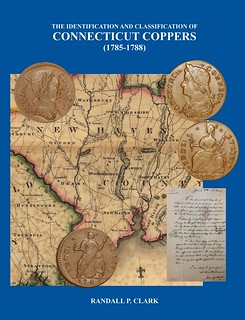 The Board of Directors of Colonial Coin Collectors Club (C4), and the C4 Publications
Committee, extend their heartfelt congratulations to Randy Clark for receiving the 2021
Numismatic Literary Guild's Book of the Year award for The Identification and Classification of
Connecticut Coppers (1785-1788). The award was presented at the 2022 ANA World's Fair of
Money in Chicago last month.
The Board of Directors of Colonial Coin Collectors Club (C4), and the C4 Publications
Committee, extend their heartfelt congratulations to Randy Clark for receiving the 2021
Numismatic Literary Guild's Book of the Year award for The Identification and Classification of
Connecticut Coppers (1785-1788). The award was presented at the 2022 ANA World's Fair of
Money in Chicago last month.
This recognition is richly deserved. C4 is a non-profit numismatic organization of coin collectors dedicated to the dissemination of useful knowledge about Colonial Era coins. C4 has published other award winning books on Colonial numismatics but this is the first time one of its publications has received the top NLG award. Congratulations to Mr. Clark for this well-deserved recognition.
Chris McDowell submitted this nice note on behalf of the Colonial Coin Collectors Club. -Editor
To read the earlier E-Sylum article, see:
2022 NUMISMATIC LITERARY GUILD AWARDS
(https://www.coinbooks.org/v25/esylum_v25n34a05.html)
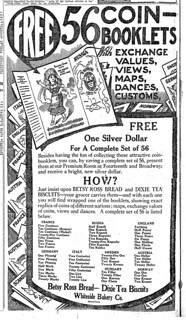 'Story of Money' Trade Cards Follow-Up
'Story of Money' Trade Cards Follow-Up
Regarding Julia Casey's find of information on the 'Story of Money' Trade Cards,
Steve Woodland writes:
"This info is awesome! Please pass on my great thanks to Julia."
DONE. We love it when readers can answer longstanding research questions. -Editor
To read the earlier E-Sylum article, see:
NOTES FROM E-SYLUM READERS: SEPTEMBER 4, 2022 : 'Story of Money' Trade Cards List Found
(https://www.coinbooks.org/v25/esylum_v25n36a13.html)
Dealer Charlie Dochkus
Dave Hirt writes:
"The other day I was looking through a book, and found a note about dealer Charlie Dochkus. Do any of our readers remember him? He traveled from Philadelphia to an auction house near Boyertown Pa. Almost everything in that place was for sale. Farm items, Coins, Stamps, Antiques, etc. The coins were sold at auction. I think it was around 1954 or 1955.
Afterwards I walked with a group to the Dochkus car in the parking lot. The trunk was opened. It was Full of numismatic items for sale. There were a lot of bargains, but I was still a teenager without much cash, so I did not buy anything."
Interesting. Does anyone else have a Charlie Dochkus story? -Editor
First Auction Catalog Image of Paper Money
Dennis Hengeveld writes:
"I am doing research on World Paper Money in pre-World War II auction catalogs. There is a surprising number of listings in early catalogs, which was unexpected (but a nice surprise). The earliest lots with World Paper Money I have found so far were offered in the 1870s (a variety of items, including banknotes from Argentina and China), which is amazing since there wasn't a whole lot of world paper money in circulation at the time, and the number of collectors must have been minimal. Unfortunately, the detail in the listings is minimal, but this is of course typical for auction catalogs of that era. That said, this got me thinking. We know that there were regulations regarding the reproduction of currency and postage stamps, which means that it is unlikely any were plated that early. But, what would be the first appearance of a plated piece of US and/or World Paper money sold in an auction? Maybe some of your readers would know?"
Great question! I don't know. Readers? -Editor
The Papers of Clifford Hewitt
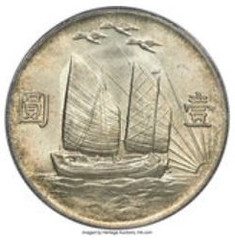 American Numismatic Society Librarian David Hill writes:
American Numismatic Society Librarian David Hill writes:
"It was interesting to see the photograph of the junk shown on the 1932 Sun Yat-sen silver dollar in last week's E-Sylum.
"This photograph, along with other pasted images, was used in several preliminary designs that can be found in some papers of Clifford Hewitt in the ANS Archives. I wrote about Hewitt a while back for ANS Magazine, which is available on the Newman Numismatic Portal."
Thank you. David also sent the above images. -Editor
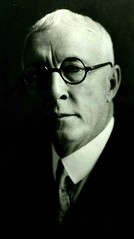 For the ANS catalog entry for the Hewitt papers, see:
For the ANS catalog entry for the Hewitt papers, see:
Clifford Hewitt Chinese Mint collection, 1930 - 1971
(http://numismatics.org/archives/ark:/53695/nnan0061)
To read the ANS Magazine issue on NNP, see:
American Numismatic Society Magazine: 2013, Issue 3
(https://nnp.wustl.edu/library/book/534419)
To read the earlier E-Sylum article, see:
THE JUNK ON THE 1932 SUN YAT-SEN DOLLAR
(https://www.coinbooks.org/v25/esylum_v25n36a29.html)
The Price Veterans Paid For Our Freedom
Darryl Atchison writes:
"I just finished reading this week's edition of The E-Sylum and, as usual, it's brilliant.
"The article on Peggy Terry and the 'owed' 5 shillings was both very moving and very important. Hands down, my favorite article in this issue and a story that I am sure I will remember for many years!
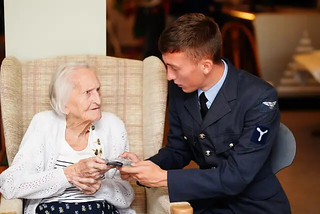 "It's very clear that a genuine and sincere connection was made between
Mrs.Terry and the young serviceman who is now stationed at the same
airfield as she was in World War II and this isn't unusual. Servicemen and
servicewoman from around the world can understand and appreciate the
stories we tell each other about our experiences - whether those stories
are tragic or comedic. Often times, the same story can be both!
"It's very clear that a genuine and sincere connection was made between
Mrs.Terry and the young serviceman who is now stationed at the same
airfield as she was in World War II and this isn't unusual. Servicemen and
servicewoman from around the world can understand and appreciate the
stories we tell each other about our experiences - whether those stories
are tragic or comedic. Often times, the same story can be both!
"Sadly, I fear that most of the current generation have no understanding of the price that Allied veterans paid for our freedom - in World War I and II particularly.
"Congratulations to both Mrs. Terry and the RAF. I have no doubt that her family will cherish the coins and photos that Mrs. Terry was given on the day for many years to come.
"And seeing Mrs. Terry receive even this tiny bit of recognition and appreciation was a great way to start off my week!
"Thanks again for another fantastic issue."
Thanks also to David Pickup for submitting the story. -Editor
To read the earlier E-Sylum article, see:
LOOSE CHANGE: SEPTEMBER 4, 2022 : Royal Air Force Vet Debt Paid
(https://www.coinbooks.org/v25/esylum_v25n36a31.html)
Queen Elizabeth II Banknotes of Ceylon
"A note from my wife's father's collection (now with me) appeared in the Sunday Times today as a tribute to her passing.
"The Ceylon currency notes with her portrait, dated 1952-June-3rd, a year before her coronation are the world's first dated Currency Notes with her portrait after she ascended to the throne on 1952 Feb 6th. The denominations Rs1, Rs2, Rs5, Rs50, and Rs100, excluding the Rs10, were issued with the date 3rd June 1952. Hong Kong dated 1952 July 1st, Cyprus 1952 September 1st, and Bermuda 1952 October 20th followed.
"The Ceylon Rs 10, dated 1953-July-1st is the first to be issued after her coronation on 1953 June 2nd.
"Was Ceylon also the first Commonwealth Nation to stop using the QEII portrait on their Banknotes? Last issued with date 1954 October 16th with new notes after the Sinhala Only Act being issued with 1956-07-30 and the Armorial Ensign of Ceylon. (Please correct me if any statement of this paragraph is wrong, Thanks)
"Why did the Queen appear on Bank of England Notes first only in 1960? Even the colonies did not use the British Monarch's image until the mid-20th century. Ceylon used the Monarch's image on banknotes only from 1941 to 1954, but on coins from 1815 to 1957. Why is there such a difference in the usage of the Monarch's image between coins and banknotes?
"I hope an E-Sylum subscriber will explain."
All great questions. Can anyone help? -Editor
To read the Sunday Times piece, see:
Ceylon, first in the world to have the Queen's portrait on currency
(https://www.sundaytimes.lk/220911/business-times/ceylon-first-in-the-world-to-have-the-queens-portrait-on-currency-2-494440.html)
For more information on Kavan's website, see:
Central Bank of Ceylon
Queen Elizabeth II - 1952-1954
(http://notes.lakdiva.org/cbc/1952_qeii.html)
Australian Florin Lieutenant Bars
Dave Lange writes:
"I've been a subscriber to the magazine Naval History since its first issue in 1986. I spotted this interesting piece with a numismatic connection in the October 2022 issue."
The article discusses makeshift Lieutenant bars fashioned from an Australian florin following a promotion at sea during WWII, far from a Navy uniform shop. Cool. -Editor
National Book Lovers Day
Roger Moore writes:
"Thought this was cute."
Thanks. We missed celebrating National Book Lovers Day last month (August 9th). Follow the link below for Part 2 of the cartoon. -Editor
To read more Adrienne Hedger cartoons, see:
Happy National Book Lovers Day
(https://www.hedgerhumor.com/happy-national-book-lovers-day/)
MORE 2026 INDEPENDENCE COMMEMORATIVE IDEAS
Wayne Pearson passed along these refinements to his earlier design ideas for coins to mark the 2026 semiquincentennial of U.S. independence. -Editor
Cent Reference:
https://www.socalleddollar.com/abworldsfairs.html
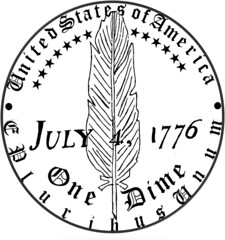

Dime: based on non-circulating commemorative coin by Marcel Jovine
Quarter: based on non-circulating commemorative coin by Thomas Cleveland
The half dollar is a heptagon shape so we could make them 27.5 mm like the U.K. so the vending machine industry could accept them. Design concept taken from:
https://www.colorourtown.com/product-page/color-historic-philadelphia
To read the earlier E-Sylum article, see:
2026 INDEPENDENCE COMMEMORATIVE IDEAS
(https://www.coinbooks.org/v24/esylum_v24n34a14.html)
UMBRIA DUCAL PALACE COIN AND MEDAL EXHIBIT
Jeff Rock submitted this nice report on a pleasant numismatic surprise seen on tour in Italy. Grazie! -Editor
A Numismatic Surprise in Umbria, Italy: Ducal coins and medals on display
 As every
As every coin wife
knows, numismatists seem to have a special radar that leads them directly
to coins, even when far away on vacation, somewhere with no advance knowledge of
numismatics in the region. Such was the case for me, spending a couple weeks in Umbria, the
central part of Italy. A day trip of an hour-and-change on a bus to the medieval cliff-face town
of Gubbio led to the usual wandering of streets, stopping in small churches, looking at Italian
clothes that could never possibly fit an American frame, grabbing a gelato or two in the summer
heat and, of course, stopping in at museums and historical buildings.
One such building was the Ducal Palace, built in the Renaissance style in 1470, literally atop pre-existing medieval buildings, and is the only Renaissance building in this small city. The contents were stripped off and sold by later owners (including a wonderful painted studio that is now in the Metropolitan Museum of Art in New York), so there is little there in the way of period furniture or original paintings, though the upper floor has a trove of paintings of the area owned by the city and private collectors.
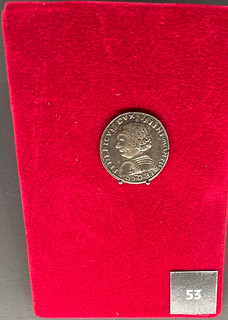 My surprise was that on first entering there was a display of coins and medals, four nice-sized
cases that take up an entire, small room. The medals relate both to the owners of the palace over
time, but also a nice representative display of works of medallic art spanning the Italian
Renaissance. There are 37 medals on display, 7 of the Duke of Urbino Frederico da Montefeltro,
and his family. There are numerous examples of medals by Pisanello and other major artisans of
the era, and there are a couple gold examples as well (I do not know enough about the series to
comment on whether they are contemporary casts or ones made a bit later, but most are
provenance to museums and private collectors who loaned them). For those whose Italian, like
mine, is non bene, the descriptions are given in both Italian and English.
My surprise was that on first entering there was a display of coins and medals, four nice-sized
cases that take up an entire, small room. The medals relate both to the owners of the palace over
time, but also a nice representative display of works of medallic art spanning the Italian
Renaissance. There are 37 medals on display, 7 of the Duke of Urbino Frederico da Montefeltro,
and his family. There are numerous examples of medals by Pisanello and other major artisans of
the era, and there are a couple gold examples as well (I do not know enough about the series to
comment on whether they are contemporary casts or ones made a bit later, but most are
provenance to museums and private collectors who loaned them). For those whose Italian, like
mine, is non bene, the descriptions are given in both Italian and English.
For the two display cases of coins, there are 35 examples on display, ranging from the earliest coinage of Gubbio (which though small was chosen as a site for the main mint after obtaining the right to coin money from Pope Martin V) in 1404, for a bit over a century, ending with the coinage of Guidobaldo di Montefeltro in 1508. The coins are from private collections, but also boast some wonderful pedigrees, including Vittorie Emmanuel III, King of Italy until 1946. By far the most important coin is the unique silver lira made sometime after 1474, which bears an extremely realistic portrait of Frederico and was likely produced shortly after he received that title; it hails from the famous Nicolo Papadopoli collection, and is the single coin depicted in the photos.
Even though centuries and thousands of miles removed from my own areas of specialty, the exhibit was enough for me to stop and examine – and admire the art and skill of the time. Sometimes half the fun of travel is wondering just how numismatics will find us.
Jeff adds:
"While most city museums I've been to in Italy have a few coins here or there they tend to either be ground finds from the area (which are certainly interesting, but seldom pretty), or a more generic group of emperors or the like. Finding something like this that was clearly put together with a sense of pride by collectors in the town is really nice to see! I don't know a whole lot about ancients, but I do know if I ever retire to Italy I would almost certainly have to start collecting them. I think the addiction ends only when you are 6 feet under!"
2022 NUMISMATIC WRITERS ANA AWARDS
The ANA presented several awards to numismatic writers this year. Congratulations to all! -Editor
The American Numismatic Association's 2022 literary awards – recognizing articles published in the 2021 volume of its official magazine, The Numismatist – were presented during the Member and Awards Celebration at the Chicago World's Fair of Money® on Aug. 18. The Numismatist was launched by ANA founder and first editor Dr. George F. Heath in 1888.
The Heath Literary Award, introduced in 1949, acknowledges outstanding articles published in the preceding 12 months.
- First place went to David Schenkman for "Whitehead & Hoag: Advertising Innovators" (April 2021). The author will receive $250 and an engraved nickel-silver medal designed in 2013 by artist and ANA member Jamie Franki, and a certificate.
- David Schenkman earned second place ($100, an engraved bronze medal and a certificate) for "Company Stores & Scrip in America, Parts 1 & 2" (August-September 2021).
- In third place (engraved bronze medal and a certificate) is John Nebel for "Andragoras: Parthian Governor or Noble Cypriot?" (March 2021).
The Wayte and Olga Raymond Memorial Literary Award, endowed in 1978 by the late John J. Ford Jr., is presented for articles that display original and comprehensive research in U.S. numismatics.
- David McCarthy received first place ($400 and a certificate) for "An Act of Independence" (July 2021).
- Second place ($200 and certificate) goes to William D. Hyder & Jeff Shevlin for "The Other Continental Dollar: Montroville Dickeson's Commemoratives" (October 2021).
- William Eckberg received third place (certificate) for "Gobrecht, Peale, Saxton & the Cents of 1835-57" (May 2021).
Founded by an anonymous donor, the Catherine Sheehan Literary Award for U.S. Paper Money Studies includes $50 and a certificate for first place.
- David Schenkman took the top prize for "Company Stores & Scrip in America, Parts 1 & 2" (August-September 2021).
- Second place (certificate) went to Bill Gunther, Ph.D. for "It's Not the Destination, It's the Journey" (February 2021).
- Benjamin Dieter R. Hellings received third place (certificate) for "Yale Art Gallery's Educational Series Proofs & Progressives" (February 2021).
The Prue and Arthur Fitts Literary Award for Ancient and Medieval Coinage Studies recognizes literary excellence in those fields.
- Francis Jarman received first place ($250 and a plaque) for "The Apostles on the Road" (May 2021).
- Earning second place (certificate) was Mike Gasvoda for "Alexander the Great" (December 2021).
- Allen G. Berman received third place (certificate) for "The Spanish Marches" (March 2021).
All feature articles published in The Numismatist automatically are considered for the Heath Literary Award; likewise, all qualifying articles are evaluated for the Raymond, Sheehan and Fitts Awards. For information about submitting manuscripts for review and possible publication, visit money.org/the-numismatist/submission-guidelines.
The 2022 ANA Young Numismatist (YN) Literary Awards were announced during the ANA's annual Summer Seminar Banquets. The three award categories are generously funded by Whitman Publishing and named after authors dedicated to educating the next generation of numismatists.
The Bill Fivaz Young Numismatist Literary Award honors numismatist writers who are aged 8 to 12. This year's first place recipient was John Swindling for "The Gold Spike Ceremony and My Favorite Golden Spike Commemoratives." Elliot Eng received second place with "Class 1 1804 Dollars: The Epitome of United States Coinage." In third place was Caleb Black for "Great Depression Era Coinage."
The Q. David Bowers Young Numismatist Literary Award honors numismatist writers who are aged 13 to 17. This year's first place recipient was Wesley Haynes for "Currency During Crisis: A Brief Analysis of the Effect of the Civil War on Coinage & Paper Money." Jackson Hancock placed second with "Say Goodbye to the Cent?!?" and Collin Bube took third with his paper "The Connecticut Copper: A Complex Coin."
The Kenneth E. Bressett Young Numismatist Literary Award is given to writers between the ages of 18 and 22. This year, first place was won by CJ Buchanan for "Estimating the Mintage of 1790 & 1791 Overdates of 1789 Catherine II EM 5 Kopeks." No entries were submitted for second and third place.
The first-place winners received a $500 cash prize, plus a $500 voucher with which to build a personal library of numismatic books produced by Whitman Publishing. Second- and third-place winners received book vouchers for $200 and $100, respectively. To learn more about this program, visit money.org. Select "Awards" from the "Community" dropdown menu.
VOCABULARY TERMS: LUCKY CHARM, LUCKY PENNY
Here's another entry from Dick Johnson's Encyclopedia of Coin and Medal Terminology. -Editor
Lucky Charm, Lucky Penny. A medallic item intended to be carried by a person, the item purporting to bring good luck; an amulet or talismanic medal. Ancient man carried such talismans; Egypt was a source for many of these since the time of the pharaohs. Such items contain symbolic designs, often highly mysterious. The custom has continued throughout the centuries to modern time were lucky charms, pocket pieces, pendants and other medallic forms are produced, often encouraged by religious, fraternal or other groups.
Lucky pennies are a type of talismanic medal, largely inspired by large bronze pennies of England and Early America. Masonic and other fraternal organizations include carrying such medals as part of each member's ritual. The item contains symbolic devices – often elaborate –sponsored by the local lodge; it also contains the member's name and class or degree of statues. Many thousands of these have been issued, sponsored by lodges in many localities. Large collections have been formed and catalogs published listing the many varieties. The condition of most lucky pennies do, indeed, exhibit the fact they were carried as pocket pieces.
See talisman.
To read the complete entry on the Newman Numismatic Portal, see:
Lucky Charm, Lucky Penny
(https://nnp.wustl.edu/library/dictionarydetail/516249)
WILLOW GENE HERREN DENISE (1904-1966)
In response to Pete Smith's question last week, Dave Lange wrote:
"I don't know for certain that she was the ANA's first female librarian, but in my reading I frequently come across the name D. Dee DeNise, who became the librarian in 1951. It seems that her first name was Gene, but since that's typically the spelling of a male she evidently preferred to go by Mrs. D. Dee DeNise. How she arrived at that name I don't know."
Pete Smith submitted this article on ANA Librarian Mrs. D. Dee De Nise. Thanks! -Editor
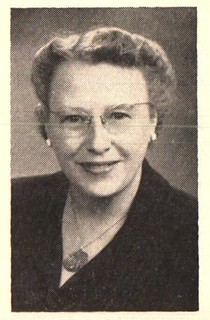 Last week I posed the question,
Last week I posed the question, What was the first name of the first woman to serve as ANA
Librarian?
The first woman librarian was generally known as Mrs. D. Dee DeNise. There were also
references to Gene DeNise. With Gene
generally considered a man's name, and Dee
generally considered a woman's name, the name of the librarian and her husband may have been
confused. So, who was D. Dee DeNise?
Dwight Dee DeNise was born in Rock Springs, Colorado, on February 19. 1902. He was raised on the ranch of his parents, George and Catherine Gantz DeNise. He graduated from the University of Washington. He worked as an electrical engineer for Seattle City Light.
At college he met Willow Gene Herren and they were married in Seattle on September 11, 1933. They had a son and a daughter. After the death of his first wife, he married Gada Mildred M. Turner.
He joined the ANA as member 16730 in October, 1948. His wife was one of the sponsors.
He was a rock collector and past president of the Lake City Rock and Mineral Association.
He died at Evergreen Convalescent Center in Olympia, Washington, on December 1, 1992.
She was born on January 15, 1904. In the 1910 Census, she is listed as Willow E. Herren, born in Oregon, the daughter of Dora S. Herren (1881-1967) who is a school teacher. By 1930, Dora was a school principal. Willow's father was James Hall Herren (1868-1953). Her parents were married in 1900 but divorced by 1910. Most records show her name spelled Herren. A few records have the name as Herron.
In the 1910 and 1920 Census, her name was listed as Willow E. Herren. Perhaps her middle name was Eugene or the census taker converted Gene to an E.
She graduated from the University of Washington. At the time of the 1930 Census, she was a public school teacher.
She was married on September 11, 1933. The marriage register names the groom as D. Dee DeNise and the bride as Willow Gene Herren. This is one of few records with her first name.
The August 1946 issue of The Numismatist listed her as Mrs. D. Dee De Nise and member 12959. She later converted to life membership number 265.
She was secretary for the Seattle Coin Club in 1947 to 1954. She also served as secretary for the Pacific Northwest Numismatic Association.
When Ole P. Eklund died on February 22, 1950, Mrs. DeNise described him living in a four room house with no electricity. His two front rooms held bookcases with 30,000 books and 40,000 coins. Mrs. DeNise conducted an April 20, 1951, mail bid sale to dispose of the estate.
She was appointed ANA Librarian to replace Ted R. Hammer effective November 1, 1951, and the library was moved to Seattle from Wichita, Kansas. During her time as librarian, she sent out more than a thousand books each year. She resigned at the end of 1957 claiming that she did not have enough time to attend to her duties or enough space to house all the books. She was succeeded by John J. Gabarron. She edited an Index to the Numismatist published in 1958.
She died in a Seattle hospital on April 24, 1966. There was no official obituary in The Numismatist, but a tribute appeared in the July 1966 issue on page 865.
The answer to the Smarty-Pants question this week: her first name was Willow. This does not appear anywhere in The Numismatist or the Newman Numismatic Portal.
Thanks, Pete, for setting the record straight. Great history. Dave Lange was close, but no cigar this week. Tricky question! -Editor
To read the earlier E-Sylum article, see:
ROBERT MEBANE RAMSAY (1913-1996)
(https://www.coinbooks.org/v25/esylum_v25n36a14.html)
THE BOOK BAZARRE
1715 FLEET SOCIETY CONFERENCE
Ben Costello of the 1715 Fleet Society passed along this information about the group's upcoming conference. Thanks - sounds like a great event. -Editor
The 1715 Fleet Society will host the conference at the Holiday Inn Oceanside, which was a popular hangout for divers back in the early days of salvaging the wreck sites of the 1715 Fleet.
The conference is three days. The first day, October 30 (Sunday) will be a Meet and Greet for authors who have written about the Fleet. There will be about 8 authors. This event is open to members and non members alike. It will start at noon and last to 600pm.
On October 31, Day 1 of the conference we will have 6 speakers followed by a dinner meeting at 6 pm. Then on Tuesday, November 1, we will have two speakers in the morning followed by a round table in the afternoon followed by the final speaker of the day, Bob Evans who will talk about shipwrecks as time capsules.
SCHEDULE OF EVENTS:
Sunday, October 30, 2022
-
 12:00 p.m. Meet & Greet and Book Signing in the Windward Room. Authors who will be present to sign and sell books. The authors attending will be Terry Armstrong, Allen Balogh, Randy Lathrop, Steve Singer, Dave Crooks, Alex Kuze, and Margaret Weller. This is open to members as well as the public.
12:00 p.m. Meet & Greet and Book Signing in the Windward Room. Authors who will be present to sign and sell books. The authors attending will be Terry Armstrong, Allen Balogh, Randy Lathrop, Steve Singer, Dave Crooks, Alex Kuze, and Margaret Weller. This is open to members as well as the public.
Monday, October 31, 2022: Day 1 Program
- 8:15 a.m. Continental Breakfast
- 8:45 a.m. Welcome — Ben Costello
- 9:00 a.m. Presentation by Charlie Winn, Advisory Board member. Charlie devotes his time to researching Fleet cobs and tracing their pedigrees often using auction catalogs and books as resources.
-
10:00 – 11:00 a.m. From the archives of Art McKee and Carl Clauson, Karen McKee will talk about
Mysteries of the Fleet
in a two-part presentation. The first part will focus on the early salvage of the Sandy Point wreck and the second half will target the 1715 -16 raids of Henry Jennings and the Cayman Island connection to those raids. Both are fascinating topics. - 11:15 a.m. – 12:00 p.m. Rounding out the morning presentations will be Margaret Weller who will share with us some of her personal reminisces of her time exploring the wreck sites of the 1715 Fleet.
- 12:00 – 1:30 p.m. Lunch Break (on your own)
- 1:30 p.m. Presentation by Terry Armstrong who will summarize current salvor technology as it applies to 1715 Fleet recovery. Terry has been very involved in this technology and will provide information that is sure to be very well received.
- 2:30 p.m. Terry's presentation will be followed by Steve Workman, a retired U.S. Navy Commander whose Ph.D. dissertation focused on a topic of major importance. To complete his thesis he interviewed a number of salvage and archaeological professionals, including Bob Marx and John de Bry, to name a few. Steve's findings will be discussed.
- 3:45 p.m. To round out the day, Tom and Terry Neiman will talk about their father Don Neiman. Don Neiman played a key role in a very important and little-known story in the early days of Fleet recovery.
- 4:30 p.m. Closing Comments — Ben Costello
Tuesday, November 1, 2022: Day 2 Program
- 8:15 a.m. Continental Breakfast
- 8:45 a.m. Welcome — Ben Costello
-
9:00 – 10:00 a.m. Presentation by John de Bry, Advisory Board member. John will talk about the
Mysteries of the Griffon
, the only ship to survive the hurricane that swallowed up the other eleven ships of the 1715 Fleet. -
10:15 – 11:15 a.m. John will be followed by Vero Beach attorney Ford J. Fegert, who will give us his insight on legal issues pertaining to the finding and recovery of treasures. He will attempt to answer the age-old question —
Can I keep it?
- 11:15 – 1:00 p.m. Lunch Break (on your own)
- 1:00 – 2:30 p.m. Roundtable discussion regarding new1715 Fleet archival research with a focus on the locations of 1715 Fleet wrecks. Joining in the discussion will be Jorge Proctor, John de Bry, Karen McKee, and others. The roundtable will be moderated by Ben Costello.
-
2:45 p.m. – 4:15 p.m. Concluding the day's events will be a program by Bob Evans who is the Chief Scientist and Historian of the S.S. Central America project. The focus of his presentation will be
Shipwrecks as Time Capsules
. - 4:15 – 4:45 p.m. Conference Conclusion — Ben Costello
For more information, or to register, see:
1715 Fleet Society Conference: Vero Beach, FL
(https://1715fleetsociety.com/shop/1715-fleet-society-conference/)
NUMISMATICS AND SEPTEMBER 11, 2001
The terrorist attacks of September 11, 2001 impacted everyone everywhere in ways large and small. No one alive that day will forget where they were and everything that happened. Here in The E-Sylum we had some first-person accounts from readers over the years. On this anniversary day, we're republishing some of these here. ANA's Outstanding Young Numismatist of the Year Eric Cheung was living near City Hall in Manhattan before heading off to Stanford. -Editor
I just heard a rumble that was about twenty seconds long. ... A couple minutes later, my mom came into my room and told me a plane just crashed into the World Trade Center.
In utter disbelief, I kicked out of my bedsheets and looked out the window and saw lots of people running around in the streets heading up Broadway away from the explosion. I also checked out the living room and saw CNN extensively covering this disaster.
About eight or ten minutes later, ... I heard a huge explosion as the legs of my bed and the floor of my 9th floor apartment shook.
The first world trade center collapsed down to the bottom...
I walked not ten feet from my neighbor's apartment when I heard an even louder rumble. My neighbors summoned me to return to the apartment, and in the last second as I dashed to the window, I saw the final section of World Trade Center 2 tumble straight down into the ground. My neighbors and mother were hysterical. Moments later the debris and ash of the aftermath rose into the blazingly sunny sky.
I returned to my apartment about 10:28, the hallways in my building filling with smoke. I continued down the hallway where there are windows every ten feet or so, four or five in all down about a hundred feet corridor. There was white dust atop every roof I could see, and it looked like a snowstorm had just hit us, or radioactive waste from a nuclear explosion had just rained down upon us. After a while, the two look the same, and are both frightening and frustrating in equal magnitude."
To read the complete article, see:
SEPTEMBER 11
(https://www.coinbooks.org/esylum_v04n38a02.html)
Other reports came from the American Numismatic Society, then located far uptown at Broadway and 125th. -Editor
Michael Bates sent this note:
The ANS is closed now, but with several others I'm stuck here because there's no way to get home. The chaos downtown has not had much effect this far north. Before noon, I walked 20 blocks north to the bus station for New Jersey commuters, only to find both the bus station and the George Washington Bridge closed, so I walked back.
ANS Executive Director Ute Wartenburg sent this note:
Many of you will be curious about the state of the new ANS building, which is within a few blocks of Ground Zero. Right now, we have not been able to get to William Street. Just before the attack on downtown Manhattan, subcontractors were working on the final stages of demolition on all floors in the new building. At this point we are uncertain when this work can resume.
We are also waiting to hear whether the exhibition "Drachms, Doubloons and Dollars. A History of Money" will open on October 17th as planned. Designers, mountmakers, printers, and ANS staff are on schedule, but the final decision will be taken jointly with the Federal Reserve Bank.
To read the complete article, see:
AMERICAN NUMISMATIC SOCIETY EFFECTS
(https://www.coinbooks.org/esylum_v04n38a03.html)
For numismatic bibliophiles, the opening of the long-awaited "Numismatics in the Age of Grolier" exhibit at the Grolier Club headquarters in midtown Manhattan, scheduled for September 12th, was postponed, as were Stacks and Bowers and Merena Galleries auctions scheduled for September 12-15. The New York Numismatic Club cancelled its September 14 meeting. -Editor
To read the complete articles, see:
EXHIBIT OPENING POSTPONED
(https://www.coinbooks.org/esylum_v04n38a04.html)
AUCTIONS RESCHEDULED
(https://www.coinbooks.org/esylum_v04n38a05.html)
NEW YORK NUMISMATIC CLUB MEETING RESCHEDULED
(https://www.coinbooks.org/esylum_v04n38a06.html)
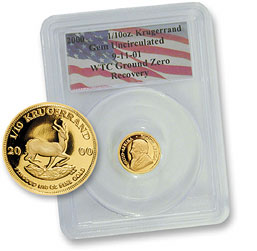
Other articles through the years discussed various numismatic commemoratives of the event, such as a gold Krugerrand marketed as being made from gold recovered from vaults at the World Trade Center. Today's article gives us a chance to publish an image of the piece, originally pictured in a Wall Street Journal article. The E-Sylum was a text-only publication until 2008 (can you imagine!) -Editor
To read the earlier E-Sylum articles, see:
SEPTEMBER 11 COINS
(https://www.coinbooks.org/esylum_v06n32a20.html)
FREEDOM TOWER "COIN" SELLER FINED
(https://www.coinbooks.org/esylum_v08n45a03.html)
NATIONAL COLLECTORS MINT ISSUES SEPTEMBER 11 ANNIVERSARY PIECE
(https://www.coinbooks.org/esylum_v09n35a23.html)
NATIONAL COLLECTOR'S MINT FINED $750,000 OVER 9/11 "COIN"
(https://www.coinbooks.org/esylum_v16n03a24.html)
PRESERVING SEPTEMBER 11 ARTIFACTS
(https://www.coinbooks.org/v20/esylum_v20n37a34.html)
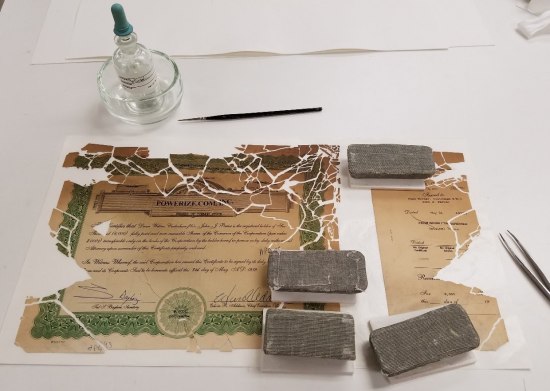
A stock certificate burned in the World Trade Center on September 11
From the Smithsonian Museum of American History
Most recently, we published a remembrance from the late Harvey Stack. -Editor
The reports were horrifying. And the Stack family was still crossing the bridge to Manhattan and the westside drive, people were running out into the streets, not even knowing where they were going. All were bewildered and kept looking up to see if more aircraft might be coming their way. Once on 155th street we passed the courtyard where the American Numismatic Society had its museum and library for many decades. We then turned south on Broadway for some blocks.
We were able to turn east on 86th street and then when we reached Broadway we were directed south again as the full length of Central Park would block us from proceeding east. We continued down Broadway, past Lincoln Center in the 60's and on to Broadway again and found ourselves within a few blocks of 56th street where we had a reserved place for our car in a garage located between 7th avenue and the Avenue of the Americas (the old 6th Avenue) and pulled into our garage. Taking our bags with us, we went next door to the Parker Meridian Hotel which had entrances on both 56th street and 57th street, directly across the street from our offices at 123 West 57th street. It was a joy to see, the window gates were still down, no signs of vandalism, our armed guard standing before the entrance. We at least made it to our "home away from home !!!
To read the complete article, see:
NEW YORK NUMISMATICS ON 9/11: STACKS
(https://www.coinbooks.org/v24/esylum_v24n38a09.html)
STEPHEN ALBUM RARE COINS AUCTION 44
Here's the press release for Stephen Album Rare Coins upcoming Auction 44. -Editor
 Stephen Album Rare Coins will hold its Auction 44 on September 15-18, 2022 at its offices in Santa Rosa,
California. The Auction is made up of 3,250 lots of Ancient, Islamic, Chinese, Indian, and General World
Coins. There is also a small selection of Ethnographic money. The pre-sale estimate is approximately
$1.4 million USD, with the final total expected to far exceed that amount.
Stephen Album Rare Coins will hold its Auction 44 on September 15-18, 2022 at its offices in Santa Rosa,
California. The Auction is made up of 3,250 lots of Ancient, Islamic, Chinese, Indian, and General World
Coins. There is also a small selection of Ethnographic money. The pre-sale estimate is approximately
$1.4 million USD, with the final total expected to far exceed that amount.
Featured in the sale is the Joe Sedillot Collection of World Coins (Part III) which includes a wide array of type coins from numerous countries. A significant number of the coins in the collection are in choice condition and were selected for encapsulation in PCGS holders. Part I was offered in the firm's January 2022 sale and Part II was offered in May 2022. Many pieces went for multiple times estimate and some items set new price records. Part III largely consists of European coins including Austria, Belgium, Denmark and France. Additional parts of the collection will be offered in subsequent auctions in 2023.
Some highlights from the sale follow:
LOT 133
ARAB-SASANIAN: Bishr b. Marwan,
fl. 692-694, AR drachm (4.00g), BCLA (al-Basra), AH75, A-27.1,
Malek-206, this remarkable coin, the Caliph Orans types, has the standard Sasanian style obverse, with
the name of Bishr b. Marwan in Pahlavi and Arabic bism Allah muhammad rasul Allah in the margin; the
reverse has the portrait of the caliph, in praying position, in place of the fire altar, flanked by two
bearded attendants in Arab dress, VF, RR
ESTIMATED VALUE $5,000 TO $6,000
LOT 730
MUGHAL: Jahangir,
1605-1628, AR rupee (11.44g), Mandu, AH1026 year 12, KM-149.19, "fath-e
dekkan" ("victory over the Deccan") commemorative, with the special couplet that translates as "the
coin of the victory over the Deccan, struck at Mandu by the Shah of the Land and the Sea // the emperor
of the time, Shah Jahangir, son of Shah Akbar"; wonderful example, without any testmarks, bold strike,
NGC graded AU55, RRR
ESTIMATED VALUE $15,000 TO $20,000
LOT 945
FUKIEN: Tao Kuang,
1820-1850, AR dollar, ND (1844), Kann-5, L&M-290, Changchow Military Ration
issue, character tong with open head variety, with single Chinese chopmark as usual for this rare type,
NGC graded AU details, RRR
ESTIMATED VALUE $10,000 TO $15,000
LOT 1001
YUNNAN: Republic,
AV 10 dollars, ND (1919), Y-482, L&M-1057; Fr-10; K-1527; WS-0652, variety with
"1" below reverse tassels, struck for General T'ang Chi-yao, military governor of Yunnan, cleaned, overall
a nice example of this rare and popular type, PCGS graded AU details
ESTIMATED VALUE $5,000 TO $6,000
LOT 1046
TIBET:
AV 20 srang, Ser-Khang Mint, BE15-54 (1920), Y-22, L&M-1063B, snow lion looking left, variety
with dot, a lovely lustrous mint state example! PCGS graded MS63
ESTIMATED VALUE $10,000 TO $15,000
LOT 1403
ANGLO-GALLIC: Edward the Black Prince,
1362-1372, AV pavillon d'or (5.31g), Aquitaine, ND, Boudeau-
508, Duplessy-1120, the Prince seated facing on throne, crowned with roses, holding raised sword and
flanked by four ostrich feathers, under Gothic canopy, with 2 leopards lying on either side of his feet
with ED: PO: GNS: REG - ANGL: PnCPS AQ around // acorned and leafy cross with rose in a curvilinear
heart-shaped lozenge, with two leopards and two lis in the angles, in a four-lobed square flanked by
clovers with + DNS: AIVTO: Z: PTECTO: ME: - IIPO: SPAVIT: COR: MEVM: B around, well struck, some
luster, EF-AU
ESTIMATED VALUE $5,500 TO $7,500
LOT 1556
ESSEQUIBO & DEMARARY: George III,
1760-1820, AR 3 guilders, 1809, KM-8, Prid-4, edge grained left,
nicely detailed despite the shallow-strike that is standard for this type, much original mint bloom
present, PCGS graded MS62, R
ESTIMATED VALUE $5,500 TO $6,500
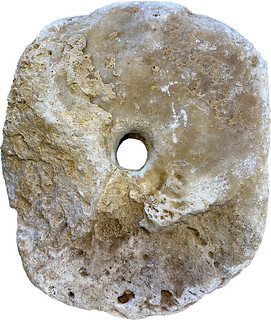 LOT 1705
LOT 1705
MICRONESIA: Yap,
rai stone money (12010g), ca. 1871-1931, Opitz p.316-321, Opitz (2011) p.533 (plate
example), 34 x 28.5 x 9cm (13.4" x 11.2" x 3.5", 26.48 lbs), made from crystalline calcite (aragonite per
Opitz), holed in the center, a very nice example of this famous ethnographic currency, VF, RR, ex Charles
Opitz Collection.
ESTIMATED VALUE $4,000 TO $6,000
SARC CEO Joseph Lang commented: We have received many kind compliments about our auctions in
the last few months, in particular about our sales featuring coins that cater to a broad audience of real
collectors. It has always been our goal to expand the size of our auctions while being mindful of
continuing to offer the interesting material that people have come to expect from our sales. It is
encouraging to hear feedback from clients who are excited to see what we will be offering in our sales.
The firm is now taking consignments for future premier and online auctions.
More information can be found on their website at www.stevealbum.com
KÜNKER AUCTION SALE 374 HIGHLIGHTS
Here's a press release with highlights from the upcoming Künker auction sale 374. -Editor
Catalog 374: Hesse and the Hessian Area – The Dr. Hans-Jürgen Loos Collection, Part 1
28 September will be thoroughly dedicated to Hesse and the entire Hessian area. Künker will offer the first part of the Dr. Hans-Jürgen Loos Collection. The economist, who headed the accounting department of a large corporation, enjoyed numismatics as a way to unwind from his daily work. An enthusiastic local historian, he was keen to create a collection that would provide an overview of Hesse's monetary history that was as complete as possible. He called his about 1,400 issues from seven centuries Minted Hessian History
. The collector stated that he made the deliberate choice not to build up a complete special collection of individual territories, but to collect a representative cross-section of Hessian coin history as an expression of the historic development of the Hessian region in the area of today's Hesse
. Modestly, Dr. Loos mentions some very rare specimens
in his preface. In fact – as in any great collection – there are both common as well as extremely rare specimens to find, which is why anyone who is interested in one of the areas that are located in today's Federal State of Hesse should study this catalog very carefully.
Part 1 of the collection covers issues from the following territories
- Landgraviate of Hesse, before and after the separation
- Electorate of Hesse-Kassel
- Fulda, abbey and diocese
- Gelnhausen, imperial mint
- County of Hanau-Münzenberg
- Hersfeld, abbey
- Fritzlar, as the mint of the archbishop of Mainz
- Münzenberg, as ducal mint
- Counties of Solms
- Landgraviate of Thuringia
- Waldeck, county and principality
- Kingdom of Westphalia
- Wetzlar, imperial mint
No. 1280: Landgraviate of Hesse. William II the Middle
, 1493-1509. Gold gulden 1506, Kassel. Extremely rare. Very fine. Estimate: 15,000 euros
No. 1302: Landgraviate of Hesse-Marburg. Louis IV the Elder
, 1567-1604. Broad double reichstaler 1595, Marburg. 2nd known specimen. Very fine. Estimate: 25,000 euros
No. 1326: Landgraviate of Hesse-Kassel. Maurice the Learned
, 1592-1627. Reichstaler 1594, Kassel. Extremely rare. About extremely fine. Estimate: 20,000 euros
No. 1495: Landgraviate of Hesse-Kassel. William VIII, 1751-1760. Ducat 1754, Kassel. Very rare. Extremely fine. Estimate: 10,000 euros
No. 1563: Landgraviate of Hesse-Kassel. William IX, 1785-1821. Double Hesse reichstaler (double William's Taler) 1789, Kassel. Extremely rare. About FDC. Estimate: 12,500 euros
No. 1646: Fulda / Abbey. Placius von Droste, 1678-1700. Double reichstaler 1687. Extremely rare. Very fine to extremely fine. Estimate: 10,000 euros
No. 1744: County of Hanau-Münzenberg. Count Philipp Reinhard, 1685-1712. Reichstaler 1695, Hanau. Extremely fine. Estimate: 20,000 euros
No. 1758: County of Hanau-Münzenberg. William IX of Hesse-Kassel, under the guardianship of his mother Maria. Conventionstaler 1764, Hanau. Extremely rare, according to Hoffmeister, only 18 specimens of this taler were minted. Extremely fine to FDC. Estimate: 20,000 euros
No. 1817: County of Solms-Rödelheim. John Augustus, John Frederick, Frederick Sigismund and John George III, 1632-1665. 1/2 reichstaler 1658, Rödelheim. Extremely rare. Extremely fine. Estimate: 10,000 euros
No. 1852: County of Waldeck. Christian and Wolrad IV, 1597-1638. Reichstaler 1625, Wildungen. Extremely rare. Very fine. Estimate: 15,000 euros
To order a catalog contact Künker, Nobbenburger Straße 4a, 49076 Osnabrück; phone: +49 541 / 962020; fax: +49 541 / 9620222; or via e-mail: service@kuenker.de. You can access the auction catalogs online at www.kuenker.de. If you want to submit your bid from your computer at home, please remember to register for this service in good time.
For more information, see:
https://www.kuenker.de/en
KÜNKER AUCTION SALE 375 HIGHLIGHTS
Here's a press release with highlights from the upcoming Künker auction sale 375. -Editor
Auction 375: Nuremberg / Selected Lösers from the Friedrich Popken Collection / Coins and Medals from Medieval and Modern Times / German Coins after 1871
The last two days of the auction week are dedicated to auction 375, which includes further special collections. For example, another part of the Frederick Popken Collection with selected lösers can be marveled at. The auction starts with a Franconian regional collection, including gold and silver coins from Nuremberg as well as a rich variety of medals by Nuremberg artists. Particularly abundant is the selection of rare tokens that is offered as part of this collection. There are also some treasures for bibliophiles among the offer.
As always, Künker presents a broad selection of German coins and medals from Anhalt to Würzburg, from the Middle Ages to the founding of the German Empire, from three-digit to five-digit estimates.
The section with world issues offers a few great rarities. For example, an original specimen of a Renaissance medal with the portrait of Henry VIII of England is on offer, celebrating him as the head of the Church of England and Ireland.
If you're interested in Sweden, you can look forward to an extensive selection of about 150 lots with coins and medals from the far North. However, there are also impressive specimens in the section with Chinese issues. Künker is able to offer as many as four great rarities form the beginning of the 20th century.
Of course, as always, there is a vast offer of coins from the German Empire including great rarities, such as a 20-mark piece by Henry XXII of Reuss-Greitz, older line, about FDC.
No. 2009: Nuremberg. Townhall taler n.d. (1688). Die by D. S. Dockler. From a Franconian regional collection. Very rare. About FDC. Estimate: 5,000 euros
No. 2041: Nuremberg. 1723 silver medal by P. P. Werner and P. G. Nürnberger commemorating the 100th anniversary of the Altdorf University. From a Franconian regional collection. From the Herbert Erlanger Coll. Very rare. Extremely fine +. Estimate: 5,000 euros
No. 2059: Nuremberg. Silver gate token for Hans Albrecht Haller of Hallerstein, 1653. From a Franconian regional collection. From the Erlanger Coll. Unique. Extremely fine. Estimate: 2,500 euros
No. 2156: Brunswick-Wolfenbüttel. Frederick Ulrich, 1613-1634. Löser of 10 reichstalers 1614, Goslar or Zellerfeld. With value mark. From the Friedrich Popken Collection. From the Preussag Collection. Extremely rare. Very fine. Estimate: 60,000 euros
No. 2169: Brunswick-Lüneburg-Celle. Christian, Bishop of Minden, 1611-1633. Löser of 6 reichstalers 1625, probably Clausthal mint. Without value mark. From the Friedrich Popken Collection. From the Preussag Collection. Probably the 2nd known specimen. About extremely fine. Estimate: 40,000 euros
No. 2262: Brandenburg-Prussia. Frederick William I the Soldier King, 1713-1740. Reichstaler 1713, Magdeburg. Very rare. Extremely fine. Estimate: 15,000 euros
No. 2393: Erfurt. Reichstaler 1633. Very rare. About extremely fine. Estimate: 10,000 euros
No. 2663: England. Henry VIII, 1509-1547. Silver medal 1545 by Henry Bayse. Extremely rare. Original strike. Very fine to extremely fine. Estimate: 50,000 euros
No. 2730: Sweden. Gustav Vasa, 1521-1560. Daler 1543, Svartsjö. Rare in this quality. Very fine to extremely fine. Estimate: 3,000 euros
No. 2898: China. Republic. 1 dollar n.d. (1923), commemorating the adoption of the new constitution under President Tsao Kun. NGC AU DETAILS CLEANED. Extremely fine. Estimate: 15,000 euros
No. 3053: German Empire. Mecklenburg-Strelitz. Frederick William, 1860-1904. 10 marks 1873. From the collection of a Swedish-Swiss entrepreneur. Very rare. Estimate: 35,000 euros
No. 3067: German Empire. Reuss, older line. Heinrich XXII, 1859-1902. 20 marks 1875. Very rare. About FDC. Estimate: 50,000 euros
To order a catalog contact Künker, Nobbenburger Straße 4a, 49076 Osnabrück; phone: +49 541 / 962020; fax: +49 541 / 9620222; or via e-mail: service@kuenker.de. You can access the auction catalogs online at www.kuenker.de. If you want to submit your bid from your computer at home, please remember to register for this service in good time.
For more information, see:
https://www.kuenker.de/en
CNG FEATURE AUCTION 121 HIGHLIGHTS
Here's the press release for Classical Numismatic Group's Auction 121, closing October 6-8, 2022. -Editor
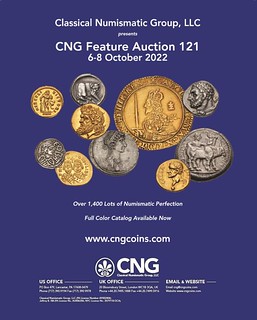 A remarkable double-portrait coin of the famous lovers Cleopatra and Mark Antony,
a spectacular gold stater of Pantikapion, and a splendid gold Triple Unite of King Charles I of England are
among the highlights of Classical Numismatic Group's Feature Auction 121, closing October 6-8 on the firm's
website, www.cngcoins.com.
A remarkable double-portrait coin of the famous lovers Cleopatra and Mark Antony,
a spectacular gold stater of Pantikapion, and a splendid gold Triple Unite of King Charles I of England are
among the highlights of Classical Numismatic Group's Feature Auction 121, closing October 6-8 on the firm's
website, www.cngcoins.com.
With 1,441 Ancient Greek, Roman, Byzantine, World and British coins at estimates totaling nearly $3.5
million, Feature Auction 121 is one of the CNG's impressive offerings ever, according to Michael Gasvoda,
Managing Director. Aside from our annual Triton auctions held in conjunction with the January New York
International Numismatic Convention, this is the strongest Feature Auction we've had in CNG's nearly five-decade history,
Gasvoda said. We are very thankful to our consignors for making CNG 121 such an
outstanding auction. With the market for exceptional coins running strong, I am sure the response from our
bidding clientele will be as fantastic as the offering.
The Cleopatra and Mark Antony coin, a silver tetradrachm minted in 36 BC at the city of Antioch in Syria, bears two astonishingly lifelike portraits of the famous couple on opposite sides. Every detail of Cleopatra's elaborate hairdo, her jewelry, the determined look in her eye – all are sharply rendered. Antony has a prizefighter's profile and a surprisingly modern-looking haircut. The coin, lot 696, carries an estimate of $50,000.
To read the complete lot description, see:
SELEUCIS and PIERIA, Antioch. Mark Antony & Cleopatra VII of Egypt. 36 BC. AR Tetradrachm. EF.
(https://auctions.cngcoins.com/lots/view/4-71VJZH/seleucis-and-pieria-antioch-mark-antony-cleopatra-vii-of-egypt-36-bc-ar-tetradrachm-ef)
The Pantikapaion gold stater, minted circa 340-325 BC at a Greek trading city on the Black Sea, boasts a stunning portrait of the god Pan wearing a wreath of ivy on the obverse and a winged griffin bearing a spear in its mouth on the reverse. Widely regarded as one of the most beautiful Greek gold coins ever struck, the stater is graded Mint State 5/5 Strike, 4/5 Surface by Numismatic Guaranty Corporation and carries an estimate of $75,000.
To read the complete lot description, see:
CIMMERIAN BOSPOROS, Pantikapaion. Circa 340-325 BC. AV Stater. NGC photo certification 6556103-001, graded MS, Strike: 5/5, Surface: 4/5.
(https://auctions.cngcoins.com/lots/view/4-71VJCC/cimmerian-bosporos-pantikapaion-circa-340-325-bc-av-stater-ngc-photo-certification-6556103-001-graded-ms-strike-55-surface-45)
The Triple Unite of Charles I, minted in Oxford in 1643 at the height of the English Civil War, is an
impressively large gold piece 44 millimeters in diameter and weighing 26.62 grams. The obverse bears a
crowned half-length bust bearing a sword and a laurel branch, while the reverse bears a Latin legend declaring
the king's support for the Protestant religion, the laws of England and the liberty of Parliament.
Graded AU
50 by NGC, the Triple Unite boasts a long auction pedigree back to the D. Mitchell Collection auction by
Glendinings in 1949. It carries an estimate of $50,000:
To read the complete lot description, see:
STUART. Charles I. 1625-1649. AV Triple Unite. Declaration type. Oxford mint; im: plume. Dated 1643. In NGC encapsulation 6455574-001, graded AU 50.
(https://auctions.cngcoins.com/lots/view/4-71VL05/stuart-charles-i-1625-1649-av-triple-unite-declaration-type-oxford-mint-im-plume-dated-1643-in-ngc-encapsulation-6455574-001-graded-au-50)
Other auction highlights in CNG Feature Auction 121 include:
Beautiful silver decadrachm of Syracuse signed by Euainetos
To read the complete lot description, see:
SICILY, Syracuse. Dionysios I. 405-367 BC. AR Dekadrachm. Reverse Signed by Euainetos. Struck circa 405-390 BC. Near EF.
(https://auctions.cngcoins.com/lots/view/4-71VJ3H/sicily-syracuse-dionysios-i-405-367-bc-ar-dekadrachm-reverse-signed-by-euainetos-struck-circa-405-390-bc-near-ef)
Striking gold trihemistater of Carthage:
To read the complete lot description, see:
CARTHAGE. Circa 270-264 BC. AV 1½ Shekels – Tridrachm. Carthage mint. EF.
(https://auctions.cngcoins.com/lots/view/4-71VJ4R/carthage-circa-270-264-bc-av-1-shekels-tridrachm-carthage-mint-ef)
Rare gold mnaieion of the Egyptian King Ptolemy IV:
To read the complete lot description, see:
PTOLEMAIC KINGS of EGYPT. Ptolemy IV Philopator. 222-205/4 BC. AV Mnaieion – ‘Oktadrachm'. Alexandreia mint. Struck circa 210-205/4 BC. Good VF.
(https://auctions.cngcoins.com/lots/view/4-71VJTI/ptolemaic-kings-of-egypt-ptolemy-iv-philopator-222-2054-bc-av-mnaieion-oktadrachm-alexandreia-mint-struck-circa-210-2054-bc-good-vf)
Rare gold aureus of the short-reigning Roman Emperor Galba, minted in Spain:
To read the complete lot description, see:
Galba. AD 68-69. AV Aureus. Uncertain Spanish mint (Tarraco?). Struck circa April-late AD 68. Good VF.
(https://auctions.cngcoins.com/lots/view/4-71VK5H/galba-ad-68-69-av-aureus-uncertain-spanish-mint-tarraco-struck-circa-april-late-ad-68-good-vf)
Attractive gold aureus of the Roman Emperor Maximian:
To read the complete lot description, see:
Maximianus. First reign, AD 286-305. AV Aureus. Rome mint. Struck AD 295-305. In NGC encapsulation 4936351-001, graded Ch AU, Strike: 5/5, Surface: 4/5.
(https://auctions.cngcoins.com/lots/view/4-71VKDF/maximianus-first-reign-ad-286-305-av-aureus-rome-mint-struck-ad-295-305-in-ngc-encapsulation-4936351-001-graded-ch-au-strike-55-surface-45)
Rare silver penny of the Anglo-Saxon Queen Cynethryth, wife of Offa:
To read the complete lot description, see:
ANGLO-SAXON, Kings of Mercia. Cynethryth. Wife of Offa, 757-796. AR Penny. Light coinage, portrait type. Canterbury mint; Eoba, moneyer. Struck 784/5. Good VF.
(https://auctions.cngcoins.com/lots/view/4-71VKUP/anglo-saxon-kings-of-mercia-cynethryth-wife-of-offa-757-796-ar-penny-light-coinage-portrait-type-canterbury-mint-eoba-moneyer-struck-7845-good-vf)
Impressive gold pound of the great Tudor Queen Elizabeth I of England
To read the complete lot description, see:
TUDOR. Elizabeth I. 1558-1603. AV Pound. Sixth issue, crown gold. Tower (London) mint; im: tun. Struck 1592-1595. EF.
(https://auctions.cngcoins.com/lots/view/4-71VKZB/tudor-elizabeth-i-1558-1603-av-pound-sixth-issue-crown-gold-tower-london-mint-im-tun-struck-1592-1595-ef)
Pre-bids on all coins in CNG 121 may be placed via the company's website, www.cngcoins.com. The live auction will commence at 9 am EDT on Thursday, October 6, with sessions continuing through Saturday, October 8, and can be followed via CNG's Auction Mobility platform on the website. To receive a printed copy of the full-color catalog and a detailed schedule, contact Classical Numismatic Group LLC at CNG@cngcoins.com, or call (717) 390-9194.
MDC MONACO OCTOBER 2022 SALE
Here's the press release for the October 2022 MDC Monaco sale. Beautiful coins! -Editor
1473 exceptional lots will be back under the hammer on the 13th and 14th of October in Monaco. MDC auction will for sure be the most important numismatic event of the end of the year. The coins and medals which will be presented go from antiquity to present days and are from all over the world. The auction will be held by the expert Nicolas Gimbert at the Métropole Hôtel, in Monaco.
Several remarkable sets will be presented:
-
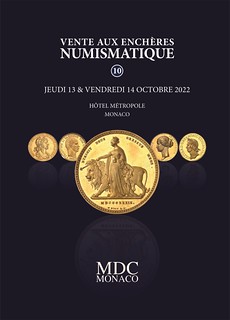 LOT 49. Caligula (37-41). Aureus with Divine Augustus 37-38, Lyon
LOT 49. Caligula (37-41). Aureus with Divine Augustus 37-38, Lyon
- LOT 75. Constantine I (307-337). Solidus ND (326), Thessaloniki.
- LOT 312. Charles V (1364-1380). Gold Royal ND (august 1364).
- LOT 377. Louis XIII (1610-1643). Gold pattern of 10 Louis, laureated head and draped bust, 1640, A, Paris.
- LOT 516. Louis XVI (1774-1792). Gold medal, Paris Royal Society of Medicine, by Duvivier ND, Paris.
- LOT 663. Louis-Philippe I (1830-1848). 5 francs Domard, Gold strike, raised lettered edge, Proof 1831, A, Paris.
- LOT 761. IIIrd Republic (1870-1940). Gold pattern of 100 francs Génie, large lettering, Proof 1878, Paris.
- Lot 767. IIIrd Republic (1870-1940). 100 francs Génie 1905, A, Paris.
- LOT 1018. James I Stuart (1603-1625). Gold Royal (Rose Ryal), third emission ND (1621-1623), London.
- Lot 1020. Scotland, Charles I (1625-1649). Gold Unite, Third emission, by Nicolas Briot ND (1637-1642),Edinburgh.
- LOT 1026 William III (1694-1702). 5 guineas, 2nd bust, 1701, London.
-
LOT 1047. Victoria (1837-1901). Gold pattern of the
Una and the lion
5 pounds, Proof 1839, London. - LOT 1297. Venice, Paolo Renier (1779-1789). Osella of 4 sequins 1784 - Year VI, Venice.
- LOT 1325. Victor-Emmanuel III (1900-1946). Gold pattern of 100 lire with Minerva and Agriculture by S. Johnson, Proof and matte 1903, Milan (Johnson).
A prestigious 448 pages-long catalogue with numerous highlights and historical information is available. Live bidding is possible on the Biddr platform.
LOT 49.
Caligula (37-41). Aureus with Divine Augustus 37-38, Lyon.
Obv. C. CAESAR. AVG. GERM. P. M. TR. POT. Bare head of Caligula facing right.
Rev. DIVVS. AVG - PATER. PATRIAE. Radiate head of Divine Augustus facing right.
Calicó 331 - RIC-9 (R3) - Giard, Lyon 159/2 (this specimen) ; Gold - 7,70 g - 19 mm - 8h.
Specimen with a well-known history : from Bourgey, 2nd to 6th of march 1925, Récamier Collection n°120 then Leu 10, 29th of may 1974, n°328 and Leu 38, 13th of may 1986, n°229 and finally NAC 54, 24th of march 2010, n°328.
NGC Ch AU 5/5 2/5 marks. Very rare with bare head of Caligula, only 3 specimen known (ours,
another in Vienna and another in Copenhagen). Minimal contact traces, otherwise outstanding
quality. Almost uncirculated.
120000 €
LOT 75.
Constantine I (307-337). Solidus ND (326), Thessaloniki.
Obv. CONSTAN - TINVS AVG. Laureated head, facing right.
Rev. VIRTVS CON - STANTINI AVG / SMTS. Standing emperor, facing left, dressed in military cloths,
holding a shield and a trophy, two captives at his feet.
RIC- - Depeyrot cf. 12/1 (head wearing tiara, no legend) - Bastien, Donativa p.78, a ; Gold - 4,47 g - 19 mm
- 6h.
Exceptional emission from Thessaloniki with multiples described by Alföldi, Die Constantinische
Goldprägung, 1963.
NGC Ch MS 5/5 4/5. Almost mint state with mint lustre and well-centered. Very rare with only a few
specimen known. Uncirculated.
30000 €
LOT 312.
Charles V (1364-1380). Gold Royal ND (august 1364).
Obv. °K'O'L° REX° - ‘FRANCOR'°. King standing under a gothic dais, crowned, holding a scepter ;
quatrefoils on the uprights.
Rev. + XP'C° VINCIT° XP'C° REGNAT° XP'C° IMPERAT. Quatrefoiled cross, leafy and flowered, in a
trefoil quatrefoil confined with 4 little crowns.
Dy.357 (Not found) - H.1 (not found) - C.454 (Charles de Navarre) - L.369 (Not found) - Fr.283 (no record
of issue) ; Gold - 3,88 g - 28 mm - 7h.
Top Pop : this is the only graded specimen !
PCGS MS63. Ponctuation using pointed ringlets. This specimen hasn't circulated much, with barely burnished surfaces. Reduced weight and 28 millimeters module : for Charles V whose Gold Royal had not been identified ! Very rare. Uncirculated.
The Gold Royal of Charles V described in the Ciani (n°454) is in fact of Charles II, King of Navarre
(Lafaurie, BSFN, 1956, p.67-68 and Dumas, BSFN, 1958, p.210-211). Lafaurie describes the conditions of
making but doesn't know any specimen. More recently, Duplessy mentions unknown type (probably
similar to Jean II's)
and not found
. However, an extensive research make it possible for us to propose an
attribution for our specimen to Charles V.
The Gold Royal of Charles V is expected to weight the same as the Franc à Cheval of Jean le Bon and the future Franc à Cheval, on the july 24th of 1364, with a gold title of 1000‰ (24 karat), a weight of 3.885 grams (63 coins for a mark) and a value of 20 sols tournois. The executive order is dated july 31 1364. At the Archives Nationales, the Z1b/56 register indicates : Charles, by the grace of God, king of France. To our friendly and royals general masters of our Coins, greatings and order. We let know that... from us and our meeting with several prelats, barons, people from good cities of the realm and others, wish and order, and ask that quickly and without waiting you shall create gold coins that will be called Gold Royals, the weight being a 1/63th of a mark from Paris and the value being 20 sols tournois each... Paris, on the 23rd of July 1364.
The production of those coins has been proven in 3 mint places : Rouen (1500 coins, account from the 20th of april to the 18th of august 1364, delivered in the 17th and 18th of august), Toulouse (7000 coins, account from the 6th of august to the 25th of october 1364, first delivered on the 12th of september) and Montpellier (16000 coins, account from the 14th of august to the 25th of december 1364, first delivered on the 10th of september). Some production orders have been given in Paris, Tournai, Saint-Quentin, Dijon and Angers.
A Gold Royal for Charles V has been published for the first time in 1973 by Georges Savès and Leandre Villaronga, specimen n°42 of the Grenade-sur-Garonne's treasure (Haute-Garonne, 1881), but was not noticed by numismatists. This coin, illustrated page 179, is described using a few caracteristics : weight of 3.88g, (obverse legend) .KOL.R...FRAnCOR, ponctuation using pointed ringlets, large flan (cropped) measuring 27.3mm vertical and 27.8 horizontal.
New elements corroborating the Savès and Villaronga's identification are brought to light by Marc Bompaire, one of the most prominent french royal and feudal coinage expert, in 1993 in an article published in the Bulletin de la Société francaise de Numismatique. In this article is presented an illustration of a Gold Royal coming from the oldest list of illustrated gold coins known (BnF, ms. nouv. acq Fr 4139, early 15th century.)
The Cabinet des Médailles of the Bibliothèque nationale de France had 6 Gold Royals, all attributed to Charles IV. 2 of them have been re-attributed to Charles V : Chabouillet 411 (3.85g) and Côte Collection 764 (3.8g).
Our specimen has some caracteristics that allow us to attribute it to this very rare fabrication. Those
caracteristics are different compared to a Charles IV Gold Royal's ones. The obverse legend is FRANCOR
and not FRA°COR. The ponctuation uses pointed ringlets, and not simple ones. There is also quatrefoils on
the uprights of the gothic dais, missing on the Charles IV's. Otherwise, our specimen has the perfect
prescribed weight (3.885 g). With this weight and a module slightly larger to the one of Charles IV, our
specimen is certainly a Gold Royal for Charles V, which was not yet clearly identified. Our specimen has a
beautiful style and his conservation is by far superior compared to the few others known (BnF).
120000 €
LOT 377.
Louis XIII (1610-1643). Gold pattern of 10 Louis, laureated head and draped bust, 1640, A, Paris.
Obv. LVDOVICVS. XIII. D. G. FRANC. ET. NAV. REX. Laureated and draped king's bust facing right,
below (date).
Rev. CHRISTVS. REGNAT. VINCIT. ET. IMPERAT. Cross composed by 8 Ls, crowned arms divided by 4 fleur-de-lys, A in a circle at the center. Dy.1293 - G.63 - Drs (1987) PP2 - Fr.405 ; Gold - 67,17 g - 48 mm - 6h. From Fraysse et Associés, Sabine Bourgey as expert, June 20th 2007, (n°161)
Well-centered strike on this spectacular flan. The king's bust is in high relief and is remarkably composed, by Jean Warin. Small rim damages at 1 and 11 o'clock obverse and 5 o'clock reverse.
Slight wear on the high reliefs and slightly spotted surfaces in reverse. Golden patina. Very rare. XF to almost uncirculated.
The making of Gold multiples to the modules of 8 or 10 Louis by Jean Warin is known by two documents
from the National Archives, published and analyzed by Fernand Arbez and Christian Charlet, Une médaille
d'or de 100 livres, à l'effigie de Louis XIII, volée et restituée à Jean Warin en 1641, BSFN, march 2014,
p.66-70. The gold multiples of 54 grams or 67.5 grams are described as 8 and 10 gold Louis coins since
1878 and the work of Hoffmann. This denomination has been taken over by Ciani in 1926, Duplessy in 1989
and 1999, Droulers in various editions, etc. However, F. Leblanc in 1690 describes those coins as pleasure
coins. More recently, for J. Lafaurie and P. Prieur, in the third unpublished volume of their work, Les
Monnaies des Rois de France, those examples are patterns of non-chosen types. The documents from the
archives published by Arbez and Charlet confirm the date of those patterns engraved by Jean Warin in 1640.
Nevertheless, those monetiform patterns didn't have any legal value. We choose the denomination 8 or 10
Gold Louis Pattern.
450000 €
LOT 516.
Louis XVI (1774-1792). Gold medal, Paris Royal Society of Medicine, by Duvivier ND, Paris.
Obv. LUD. XVI. REX – CHRISTIANISS. Draped bust facing right ; below signature B. DUVIVIER.
Rev. In the field : PRIX DE LA SOCIÉTÉ ROYALE DE MÉDECINE DE PARIS.
Nocq.- (type 5 bust) - TNG.- ; Gold - 59,27 g - 42 mm - 12h.
Top Pop : this is the only graded specimen !
NGC MS 61. A very high reliefs specimen, with mint lustre preserved under a delicate patina. Rare,
only a few other specimens known. Uncirculated.
25000 €
LOT 663.
Louis-Philippe I (1830-1848). 5 francs Domard, Gold strike, raised lettered edge, Proof 1831, A, Paris.
Obv. LOUIS PHILIPPE I ROI DES FRANÇAIS. Laureated head facing right, signature DOMARD. F.
Rev : In the center of a two-branchs wreath : 5 FRANCS (mint) (date) and below a star.
G.677a - Maz.1068A - VG.2820 ; Gold - 37 mm - 12h.
Top Pop : this is the only graded specimen ! From Paramount Collection, Heritage 3096 n°30180.
NGC PF 62 CAMEO. Proof and cameo aspect. Very rare with only 2 known specimen ! Minimal
scratch on the cheek, on the matte lustre. Minimal hairlines on the fields. Beautiful shine.
Uncirculated.
70000 €
LOT 761.
IIIrd Republic (1870-1940). Gold pattern of 100 francs Génie, large lettering, Proof 1878, Paris.
Obv. RÉPUBLIQUE FRANCAISE. Standing winged Genius of the Republic, facing right, writing
CONSTITUTION on a table, a fasces on the left, a rooster on the right ; below : signatures A.B. and Dupré.
Rev. LIBERTÉ ÉGALITÉ FRATERNITÉ. Oak wreath, value and (date) in the center, at the bottom ESSAI
between two anchors.
GEM.278.1 - G.1137 - Maz.2112a - F.cf.552 - Fr.cf.590 ; Gold - 32,25 g - 35 mm - 6h.
Second highest graded ! Very rare pattern struck during the Universal Exposition of Paris.
NGC PF 65+ CAMEO. Proof and Cameo, showing strong constrasts between mirror fields and matte
reliefs. Plain edge and large letters on the reverse. Exceptional quality with traces of dies polishing
still visible ! Uncirculated.
150000 €
Lot 767.
IIIrd Republic (1870-1940). 100 francs Génie 1905, A, Paris.
Obv. RÉPUBLIQUE FRANCAISE. Standing winged Genius of the Republic, facing right, writing
CONSTITUTION on a table, a fasces on the left, a rooster on the right ; below : signatures A.B. and Dupré.
Rev. LIBERTÉ ÉGALITÉ FRATERNITÉ. Oak wreath, value and (date) in the center, at the bottom (mint
letter).
G.1137 - F.552 - Fr.590 ; Gold - 32,25 g - 35 mm - 6h.
Top Pop : finest known specimen, among 50 submitted !
NGC MS 66. This is the finest known specimen, all dates combined ! Mint state. Only micro-traces on
the original surface. With lustre. Uncirculated.
40000 €
LOT 1018.
James I Stuart (1603-1625). Gold Royal (Rose Ryal), third emission ND (1621-1623), London.
Obv. (mint mark) IACOBVS D: G: MA - BRI: FR: ET HIB: REX. King enthroned facing, holding a scepter,
feet on a harrow, in a lilies and roses decor.
Rev. (mint mark) A. DNO: FACTVM. EST ISTVD ET EST MIRAB: IN. OC: NRIS. Shield divided by a
long and flowered cross, circled by four groups of lily, leopard and rose ; XXX above the shield.
Fr.239 - S.2632 (125) ; Gold - 12,13 g - 40 mm - 4h.
Top Pop : this is the only graded specimen ! From the Simon English Esq.
Collection and Alderman Hird
Collection, Spink 1962.
NGC AU 58. With a thistle flower as mint mark, for the third emission, very rare. Minimal traces on
the edge. Good strike, well-centered, on a well prepared flan. Outstanding quality with a lot of details.
Golden reflections. Almost uncirculated.
40000 €
Lot 1020.
Scotland, Charles I (1625-1649). Gold Unite, Third emission, by Nicolas Briot ND (1637-1642),
Edinburgh.
Obv. CAROLVS. D: G. MAG: BRITAN. FRAN. ET. ET. HIB. REX. (mint marks). Half figure bust,
wearing the crown of Scotland, in a decorated cuirass, holding a scepter and the globus cruciger.
Rev. HIS. PRÆSVM. VT. PROSIM. Crowned shield between a crowned C on the left and a crowned R on
the right.
S.5531 - KM.57 - Fr.56 ; Gold - 9,92 g - 35 mm - 6h.
NGC AU 58*. With a thistle flower and "B" for Nicolas Briot on the obverse. Minimal straight clip
(cutter mark) barely visible. Perfect strike using coining press, directed and engraved by Nicolas
Briot. Regular wear due to circulation. Exceptional patina with iridescent golden tones. Almost
Uncirculated.
18000 €
LOT 1026
William III (1694-1702). 5 guineas, 2nd bust, 1701, London.
Obv. GVLIELMVS. III. DEI. GRA. Laureated bust facing right.
Rev. MAG. BR. FRA. ET. HIB. REX (date). Cross composed by four crowned shields separated by four
scepters, lion at the center.
Fr.310 - S.3456 - KM.508 - Holloway p.163 ; Gold - 36 mm - 6h.
Top Pop : finest known specimen !
NGC MS 64+. With the high wig bust and full scepters. Lettered edge : + DECVS. ET. TVTAMEN. ANNO. REGNI. DECIMO. TERTIO +. Wonderful patina. Exceptional mint lustre. Uncirculated.
This outstanding portrait of William III has been created by the famous Sir Isaac Newton, Master of the
Royal Mint since 1696. Implicated, he orders the prosecution and conviction of many counterfeiters. Using
his mechanical skills, he also oversees the engraving of a new king's portrait. The realism of this
representation, called "fine work", is unprecedented in the Royal Mint. Very detailed treatment has been
given to the wig strands and to the depth of the bust's reliefs.
300000 €
Victoria (1837-1901). Gold pattern of the
Una and the lion5 pounds, Proof 1839, London. Obv. VICTORIA D : G : BRITANNIARUM REGINA F : D : bust facing left, wearing smooth headband ; signature W . WYON R. A. Rev. DIRIGIT DEUS – GRESSUS MEOS. The queen facing left leading a lion with her sceptre : (date) and signature W . WYON R. A. in exergue. S.cf.3851 - W&H.277 - GH.104 - Holloway p.335 = this specimen ; Gold - 40,34 g - 37,7 mm - 12 h. Top Pop : this is the only graded specimen !
PCGS PR61CAM. Plain edge and DIRIGIT in legend. Smooth headband variety, and no decorations on the Queen's cape. Large lettering on the obverse. Large beaded on the contour. A knock on the edge. Only one or two known specimen ! Very rare pattern for this mythical coin. About Uncirculated.
Conceived by William Wyon (1795-1851) in 1839 to commemorate the beginning of queen Victoria's reign
(1837), the Una and the lion
5 pounds is considered one of the most beautiful british coins. Victoria,
standing with a lion, is moving left, with the motto May God direct my steps
above her. The young queen,
20 years old, is represented as Lady Una, from Edmund Spencer's The Faerie Queene, a poem written in
1590. This is the first time a british monarch is represented as a fictitious character : England as a lion is
guided by Una, personified by queen Victoria, and her sceptre.
750000 €
LOT 1297.
Venice, Paolo Renier (1779-1789). Osella of 4 sequins 1784 - Year VI, Venice.
Obv. SALVS IMPERII. The allegory of Security leaning on a rudder, holding a spear, a canon, some
cannonballs and an anchor at her feet.
Rev. In an endless wreath : PAULI REINERJ PRINC: MUNUS ANNO VI (date) and (mint mark).
Mont.3237 - Paol.II-489 ; Gold - 13,91 g - 33 mm - 12h.
Top Pop : finest known specimen !
NGC MS 66+. By Fantin Dandolo (FD). With full mint lustre. Uncirculated.
30000 €
LOT 1325.
Victor-Emmanuel III (1900-1946). Gold pattern of 100 lire with Minerva and Agriculture by S. Johnson,
Proof and matte 1903, Milan (Johnson).
Obv. VITTORIO EMANVELE III. Bare head facing right, signature EB.
Rev. REGNO D'ITALIA framing a crowned shield of Savoy. Allegories of Italy and Rome standing, to the
right the (date) and L100 ; signature JOHNSON AC INC.
Pag.P138 - Luppino PPSJ1 ; Gold - 35 mm - 6h.
Top Pop : finest known specimen ! From Nihon Coin Auction 48, December 9th 2018, n°596.
NGC PF 65 MATTE. Proof and matte strike. The obverse is signed by Egidio Boninsegna (EB), the
reverse by Angelo Cappuccio (AC) for the firm of Stefano Johnson, in Milan. Mint state, a minimal
trace on the tip of the mustache, otherwise full mint lustre. Uncirculated.
80000 €
For more information, see:
https://mdc.mc/en/
COINS OF THE CELTIBERIANS
I learn something new with every one of Mike Markowitz' CoinWeek articles on ancient coinage. Here's an excerpt from an August 31, 2022 piece on the coins of the Celtiberians -Editor
The central plateau (Meseta in Spanish) was inhabited by Celtic tribes who migrated across the Pyrenees in several waves, beginning perhaps in the sixth century BCE. They merged with the indigenous population, creating a unique culture described by modern historians as Celtiberian
. Skilled metal workers, the Celtiberians developed the short, double-edged Spanish
sword that was adopted by the ancient Romans as the lethal weapon of the legions. Celtiberians fought a long series wars against Rome, from 181 BCE to their ultimate defeat by the forces of Emperor Augustus in 19 BCE.
Coins issued by Celtiberian cities are an important source for understanding this era of Spanish history, from the third century BCE to the final Roman conquest. Without the names of rulers, Celtiberian coins generally can be dated only approximately, on the basis of find context and hoard evidence. As many as 160 mints issued coins during the second and first centuries BCE, some of still uncertain location.
IBERIA, Celti/Celtitan. Circa 200-150 BCE. Æ As (33mm, 23.14 g, 12h). Diademed and draped male head right / CELTITAN, boar standing right on spear-head. O. Simkin, The Celtic coin that says it is?,
Chris Rudd FPL 107, fig. 1 (this coin); ACIP 2427; CNH 1; SNG BM Spain –. VF, mostly dark green patina, some gray and red on reverse. Extremely rare and among the finest known. Classical Numismatic Group > Electronic Auction 314 6 November 2013, Lot: 2, realized: $1,900.
Around 200-150 BCE, the town of Celti or Celtitan (now Peñaflor, on the Guadalquivir River in the province of Seville) issued large (23 gram) bronze coins depicting the head of an unidentified male on the obverse and a boar standing on a spearhead on the reverse. The reverse inscription in Latin letters is CELTITAN.
This rare piece has been described as the only Celtic coin that says it is.
SPAIN, Ikalesken. Circa 150-100 BCE. Denarius (Silver, 18mm, 4.04 g 5). Youthful male head to right, wearing pearl necklace. Rev. IKaLESKeN Horseman with round shield riding to left, with second horse beside him. Burgos 1106. SNGBM 1190 ff. Nomos AG > Auction 14 17 May 2017. Lot: 2. Realized: 460 CHF (approx. $470).
Ikalesken (or Ikalensken, or Ikales) was a mint of uncertain location in southern Spain, possibly in the provinces of Murcia or Alicante. It struck large issues in silver and bronze. A typical silver denarius depicts a youthful male head wearing a beaded necklace on the obverse, and a helmeted rider with a round shield, with a second horse behind him, on the reverse.
Our understanding of Celtiberian coinage rests on decades of meticulous research and scholarship by the Catalan numismatist Leandre Villaronga i Garriga (1919-2015). He authored over 20 books and 300 articles, culminating in the standard reference, Ancient Coinages of the Iberian Peninsula (2011), with 802 pages in English and Catalan, often abbreviated ACIP
.
To read the complete article, see:
CoinWeek Ancient Coin Series: Coins of the Celtiberians
(https://coinweek.com/ancient-coins/coinweek-ancient-coin-series-coins-of-the-celtiberians/)
DOES BYZANTINE COIN SHOW A SUPERNOVA?
Arthur Shippee passed along this article speculating that a Byzantine coin may show a supernova. Thanks. -Editor
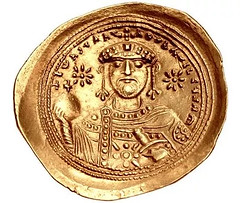 In A.D. 1054, a nearby star ran out of fuel and blew up in a dazzling supernova explosion. Though located 6,500 light-years away, the blast was clearly visible in the skies over Earth for 23 days and several hundred nights after.
In A.D. 1054, a nearby star ran out of fuel and blew up in a dazzling supernova explosion. Though located 6,500 light-years away, the blast was clearly visible in the skies over Earth for 23 days and several hundred nights after.
The explosion, now known as SN 1054, was so bright that Chinese astronomers dubbed it a "guest star," while skywatchers in Japan, Iraq and possibly the Americas recorded the explosion's sudden appearance in writing and in stone. But in Europe — which was largely ruled at the time by the Byzantine Emperor Constantine IX and the Christian church — the big, bedazzling explosion in the sky was never mentioned, not even once.
Why not? Did the church simply ignore this spontaneous star, or was a more nefarious plot to cover up the reality of the cosmos at play? According to new research, a clue to the answer may hide in an unexpected place: a limited-edition gold coin.
In a study published in the August 2022 issue of the European Journal of Science and Theology, a team of researchers analyzed a series of four Byzantine gold coins minted during the reign of Constantine IX, from A.D. 1042 to 1055. While three of the coins showed only one star, the authors suggest that the fourth coin — which shows two bright stars framing an image of the emperor's head — may be a subtle, and possibly heretical depiction of the supernova of 1054.
According to the team's interpretation, the emperor's head may represent the sun, the eastern star represents Venus — a regularly visible daytime object also called the "morning star" — while the western star represents SN 1054, which was visible for nearly a month in the daytime sky opposite Venus. The team adds that the two stars may also represent the warring Eastern Orthodox and Western Catholic churches, which split from each other during an event called the Great Schism in July of 1054.
If this interpretation is correct, and the rare coin does show SN 1054, then it suggests that Byzantine scholars may have been forbidden from studying or writing about the supernova due to religious restrictions. In essence, the church may have had a "philosophical prejudice against any observed changes in the supposedly perfect and eternal night sky," the researchers wrote in the paper. Combined with the chaos of the schism at the time, church officials may have seen it as prudent to simply ignore the supernova. But at least one clever scholar may have found a way around censorship.
"Given the Church's stand on astronomy/astrology, there would be a strong incentive not to report the occurrence of any event — including an obvious supernova — that would threaten the theological/astronomical status quo," the study authors wrote. "Perhaps one of the ways for a clever astronomer at Constantine IX's University of Constantinople to record the event would be to use a cipher, in this case, a minted coin of a special edition that was minted after the 1054 event."
The researchers also visited various museum collections to study 36 copies of this two-starred coin, which brought another peculiar detail to light. The size of the western star shown on the coins was not uniform, but seemed to shrink over time — possibly meant to represent the gradual dimming of SN 1054 in Earth's sky.
These are reasonable hypotheses, though they lack concrete evidence, the study authors admit.
To read the complete article, see:
Rare Byzantine coin may show a 'forbidden' supernova explosion from A.D. 1054
(https://www.livescience.com/byzantine-coin-supernova-1054)
THE BOOK BAZARRE
R.S. Yeoman and His Remarkable Red Book,also tells the history of Whitman Publishing as well as his own unique life story in and out of numismatics. Enjoy more than 100 years of fascinating numismatic history in 352 richly illustrated pages, 8.5 x 11 inches, hardcover. Order your copy online at Whitman.com , or call 1-800-546-2995.
18TH CENTURY ENGLISH GOLD COIN HOARD FOUND
I didn't manage to get this story into last week's issue. Nice find. Thanks to Arthur Shippee and David Pickup for passing it along. -Editor
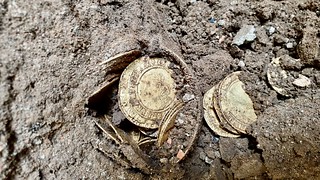 A house refurbishment in northern England has uncovered a trove of gold coins, which could be worth up to £250,000 ($290,000) at auction next month.
A house refurbishment in northern England has uncovered a trove of gold coins, which could be worth up to £250,000 ($290,000) at auction next month.
The discovery is one of the biggest hoards of 18th century English gold coins ever uncovered in Britain, according to auction house Spink & Son in a press release sent to CNN on Thursday.
The cup, described as being no larger than a soft-drink can, contained more than 260 gold coins dating from 1610 to 1727. The stash of coins has an estimated value of £100,000 ($116,00) in today's spending power, auctioneers said.
Gregory Edmund, an auctioneer with Spink & Son, said the remarkable trove is unlike any find in British archaeology or like any coin auction in living memory.
"It is a wonderful and truly unexpected discovery from so unassuming a find location," Edmund said in the press release.
"This find of over 260 coins is also one of the largest on archaeological record from Britain, and certainly for the 18th century period," he added.
"The coins almost certainly belonged to the Fernley-Maisters, Joseph and Sarah who married in 1694," reads the press release.
According to Spink & Son, the Maisters were an influential mercantile family from the 16th century to the 18th century. They traded iron ore, timber and coal from the Baltic states and several generations took up posts as lawmakers in the early 1700s.
Their family line dwindled soon after the couple died, which is presumably why the coins were never retrieved, the auction house added.
To read the complete article, see:
Coins worth up to $290,000 found under kitchen floorboards
(https://www.cnn.com/style/article/gold-coins-england-kitchen-intl-scli/index.html)
Couple find £250,000 in coins hidden under home they've lived in for 10 years
(https://metro.co.uk/2022/08/31/yorkshire-hoard-of-centuries-old-coins-worth-250000-found-under-home-17277535/)
FORT LAFAYETTE CIVIL WAR TOKEN
As part of the publicity for the upcoming Susan Trask Collection of Civil War Tokens sale, Stack's Bowers published an article by Dave Bowers on the Fort Lafayette anti-contractor token. -Editor
Shown here is an example of Patriotic token Fuld-97/389 d from our March 2021 auction (lot 8090). The obverse has MILLIONS FOR CONTRACTORS, and on the reverse NOT ONE CENT FOR WIDOWS. The headband is inscribed FORT LAFAYE, short for Fort Lafayette. The issuer of this token protested federal policies and scandals of the era—probably the most dramatic of such in the Civil War token series.
The fort was built on Hendrick's Reef, a small island in the Narrows of New York City Harbor. Construction began during the War of 1812, under the name of Fort Diamond. It was made of stone with a center courtyard and had two levels of openings or windows on the sides, with chimneys protruding from the peaked roofs that covered the quarters on various sides. Completed in 1818, the structure was renamed Fort Lafayette in 1825 during the return visit of the French hero of the American Revolution to America. Fortified with 72 heavy cannon, it guarded the approach to the harbor.
Many dissidents to the Northern cause were imprisoned in Fort Lafayette during the Civil War in what many complained were overcrowded, unhealthy conditions. During the war the largest number of prisoners at any one time was 135, of which on at least one occasion, 119 were civilians. Those confined included newspapermen who were viewed as disloyal, privateers for the Confederacy, former Union Army officers who defected to the Southern cause and who were captured, defrauders of the federal government, and a category known as Maryland prisoners.
The latter included the police commissioners of Baltimore, the entire City Council, Mayor George William Brown, members of the Maryland State Legislature, and others who were viewed as being dangerous. Among them was Francis Key Howard, a grandson of Francis Scott Key, editor of the Baltimore Exchange. His sin was writing an editorial criticizing Lincoln's suspension of the writ of habeas corpus and the imposition of martial law. The affections of certain Marylanders seemed to waver between North and South. In a sad footnote to American history, the prisoners had no judicial process of any kind.
On November 25, 1864, a group of Confederate men set fire to certain buildings in New York City, in retaliation for General William Tecumseh Sherman's destruction of most of downtown Atlanta. Robert Cobb Kennedy, earlier a captain in the 1st Louisiana Regular Infantry, was the only one caught. He was imprisoned in Fort Lafayette without judicial process and was hanged on March 25, 1865, two weeks before the end of the war.
In 1868 a fire destroyed many of the fort's facilities. It was rebuilt as a storage facility, and during World War II ammunition was store there. The fort was destroyed in 1960 during the construction of the Verrazano-Narrows Bridge when the base of the tower on the Brooklyn side was built there.
Interesting New York history. Reminded me of the day I pedaled across the Verrazano-Narrows Bridge as part of the Five Boro Bike Tour in the early 1980s. I didn't know about the old fort at the time, but you can't swing a dead rat in NYC without running into some great history. -Editor
To view and bid on lots in the Susan Trask Collection (closing September 20, 2022), see:
The September 2022 Tokens & Medals Collectors Choice Online Auction - The Susan Trask Collection of Civil War Tokens - Lots 70001-70735
(https://auctions.stacksbowers.com/auctions/3-YPHFX/the-september-2022-tokens-medals-collectors-choice-online-auction-the-susan-trask-collection-of-civil-war-tokens-lots-70001-70735?limit=48)
To read the complete article, see:
ABOUT FORT LAFAYETTE AND AN ANTI-UNION CIVIL WAR TOKEN
(https://stacksbowers.com/about-fort-lafayette-and-an-anti-union-civil-war-token/)
THE QUEEN'S CURRENCY
Howard Berlin passed along this Explainer article about Queen Elizabeth II's image on currency. Thanks. -Editor
The queen's currency
She first appeared on money when she was still a princess. That was in 1935, when Canada's 20 dollars bill featured eight-year-old Princess Elizabeth, whose grandfather King George V was then the monarch, as part of a new series of notes.
Canadian 20-dollar bills were updated with a new portrait of the queen in 1954, a year after her coronation, and her portrait also started appearing on other currencies around the world, mainly in British colonies and Commonwealth countries.
British bills did not get her image until 1960 — seven years after her coronation. That is when the Bank of England was granted permission to use her likeness on paper money, starting with the 1 pound note, though the formal and regal image was criticised for being too severe and unrealistic.
She became the first monarch to be depicted on British banknotes. British coins, meanwhile, have featured kings and queens for more than 1,000 years.
Currencies outside the UK
At one time, Queen Elizabeth II appeared on at least 33 different currencies, more than any other monarch, an achievement noted by Guinness World Records.
Her image is still featured on money in places where she remains a beloved figure, such as Canada, and continues to incorporate the Union Jack into their flags, like Australia and New Zealand.
She is also found on notes and coins issued by the Eastern Caribbean Central Bank, the monetary authority for a group of small nations, including Antigua and Barbuda, Dominica, Grenada, Montserrat, St Kitts and Nevis, St Lucia, and St Vincent and the Grenadines.
To read the complete article, see:
Queen Elizabeth is featured on several currencies – now what?
(https://www.aljazeera.com/news/2022/9/10/queen-elizabeth-is-featured-on-several-currencies-now-what)
LOOSE CHANGE: SEPTEMBER 11, 2022
Here are some additional items in the media this week that may be of interest. -Editor
Arthur Shippee passed along this article about pre-colonial African coins. Thanks. -Editor
The Aksumite of Northern Ethiopian are the early tribes of Africa to introduce coins in the 2nd to the 9th century as a means of trading. These coins were made of gold, a little bronze and a minute quantity of silver.
The Aksumite kings initially decreed the coins should bear Greek inscriptions, but, was later amended and Amharic text was embossed on the coins, according to Britannica.
The traditional coins which were used by the Ethiopians temporarily went into extinction as a result of foreign alliances and allegiance.
King Menelick, emperor of Ethiopia between 1889 and 1913, restored the coins but rather as silvers with an embossment of the Lion of Judah. He believed he was the direct descendant of King Solomon and Queen Sheba.
The Ethiopians were not the only African nations to have started using coins as means of transaction before the arrival of the Europeans.
To read the complete article, see:
Coins used by African nations before colonialism and post-independence
(https://face2faceafrica.com/article/coins-used-by-african-nations-before-colonialism-and-post-independence)
A common theme in the news seems to be challenge coins with controversial designs. -Editor
KDFW Dallas Police Department investigating 'racist' challenge coin rendering August 31, 2022 The Dallas Police Department said it is investigating a so-called challenge coin made by a white officer that the head of the Dallas Black Police Association called "racist."
To watch the complete news report, see:
Dallas Police Department investigating 'racist' challenge coin rendering
(https://news.yahoo.com/dallas-police-department-investigating-racist-221401131.html)
To read an earlier E-Sylum article, see:
LOOSE CHANGE: JUNE 12, 2022 : Creator of Offensive Maryland Challenge Coin Identified
(https://www.coinbooks.org/v25/esylum_v25n24a32.html)
An Olympic swimmer generated a great deal of comment with an artsy photo with her medals. -Editor
 Olympics swimmer Linda Cerruti has hit back at
Olympics swimmer Linda Cerruti has hit back at sexist
comments on a photo where she's posing upside down with her medals from the European Aquatics Championships.
The photo in question, which was posted by the Italian swimmer last week, showed her posing in an acrobatic upside-down pose along with the eight medals she won at the championships in Rome.
The post, which has received tens of thousands of interactions and many messages of support, shows the medals draped along Cerruti's legs as she does the splits.
However, two days after sharing the picture the swimmer posted a follow-up message explaining that she's received thousands of sexist
and vulgar
comments beneath the image.
Two days ago I shared a photo taken at the beach where I always go, where I developed my first dreams, a place that has great symbolic value for me,
she wrote. The photo shows me in an artistic pose, typical of my sport, upside down and doing the splits along with the eight medals I won during the best European Championship of my career."
To read the complete article, see:
Olympic swimmer responds to ‘sexist' comments on her ‘upside down' medal photo
(https://ca.sports.yahoo.com/news/olympic-swimmer-responds-sexist-comments-045349294.html)


